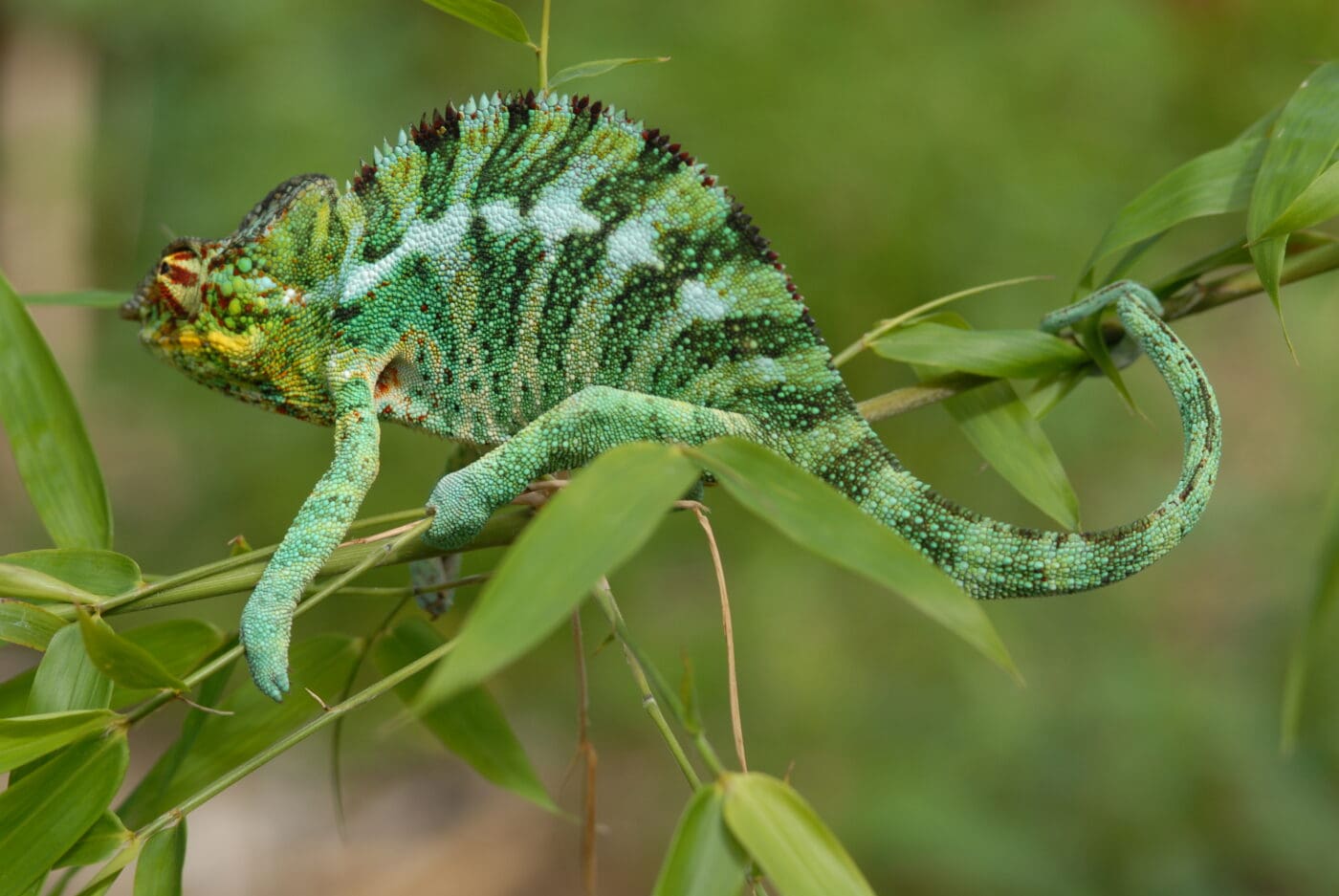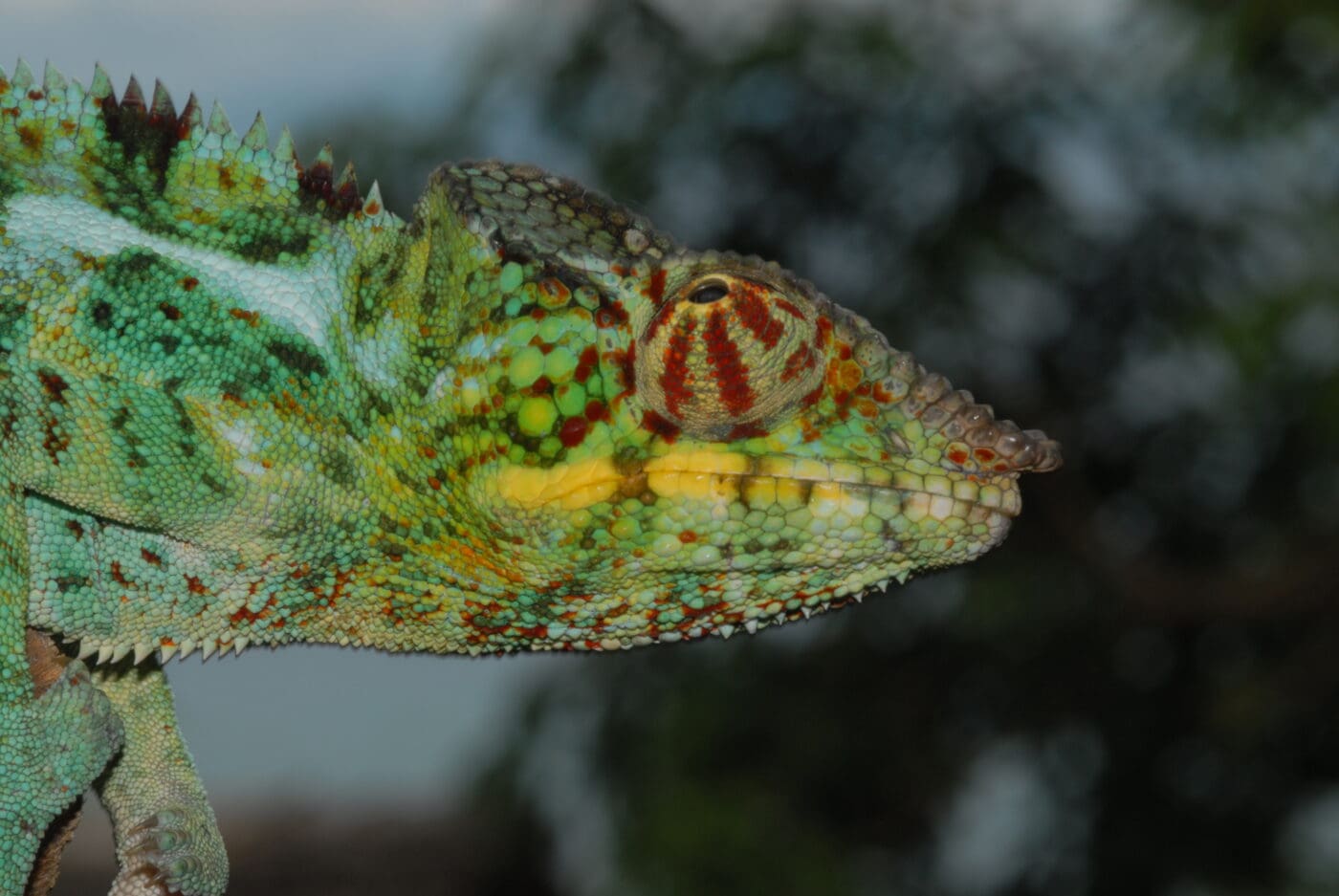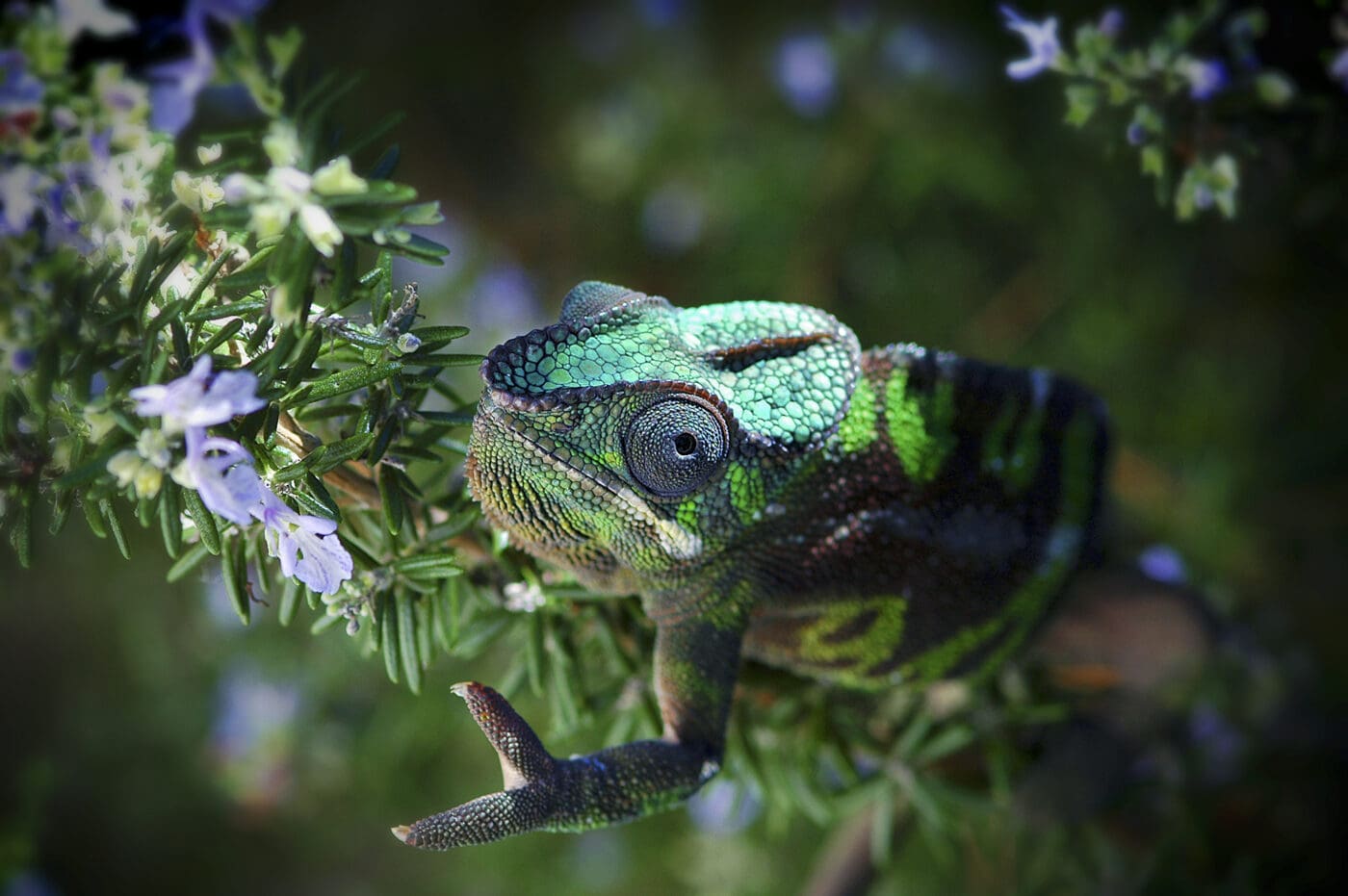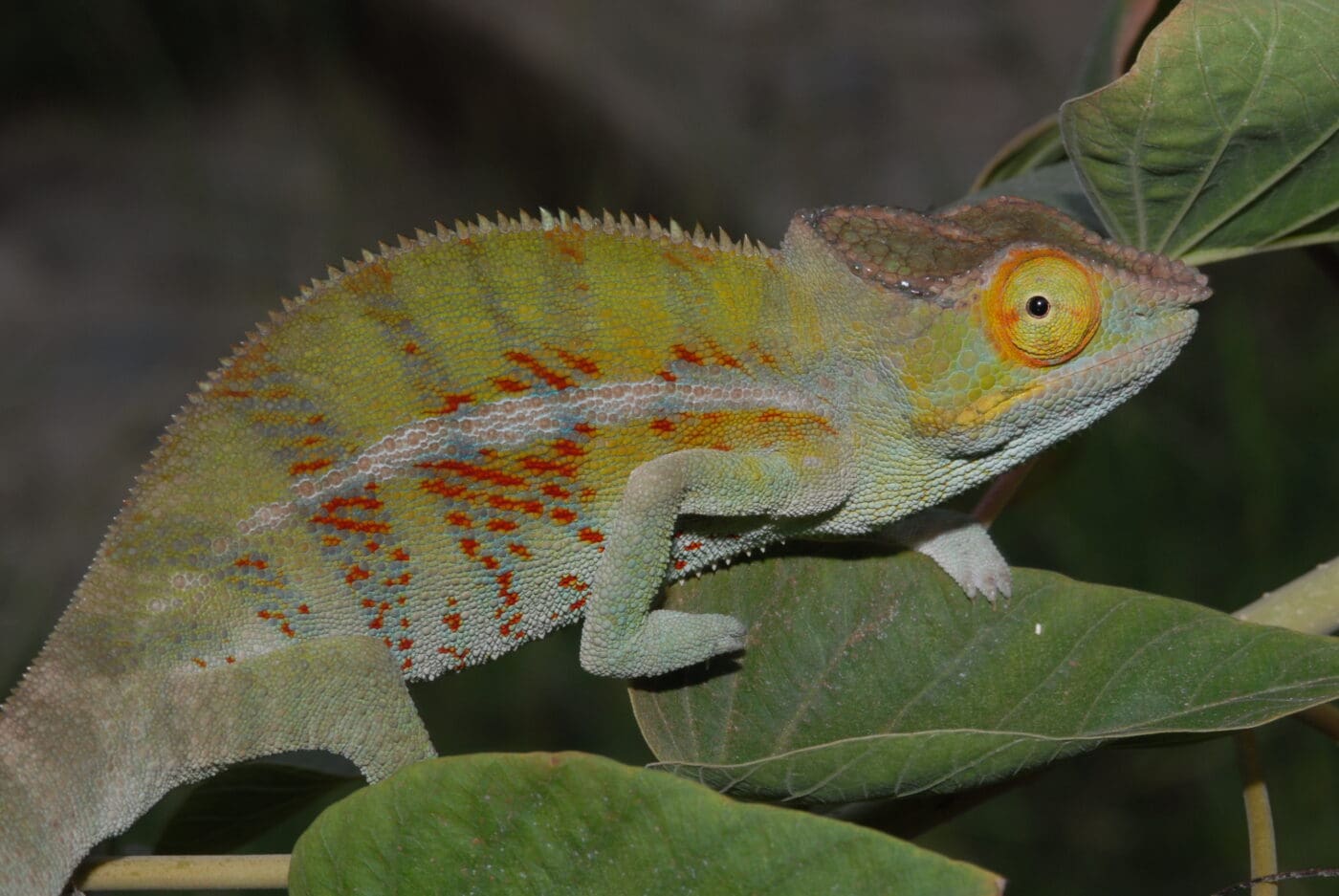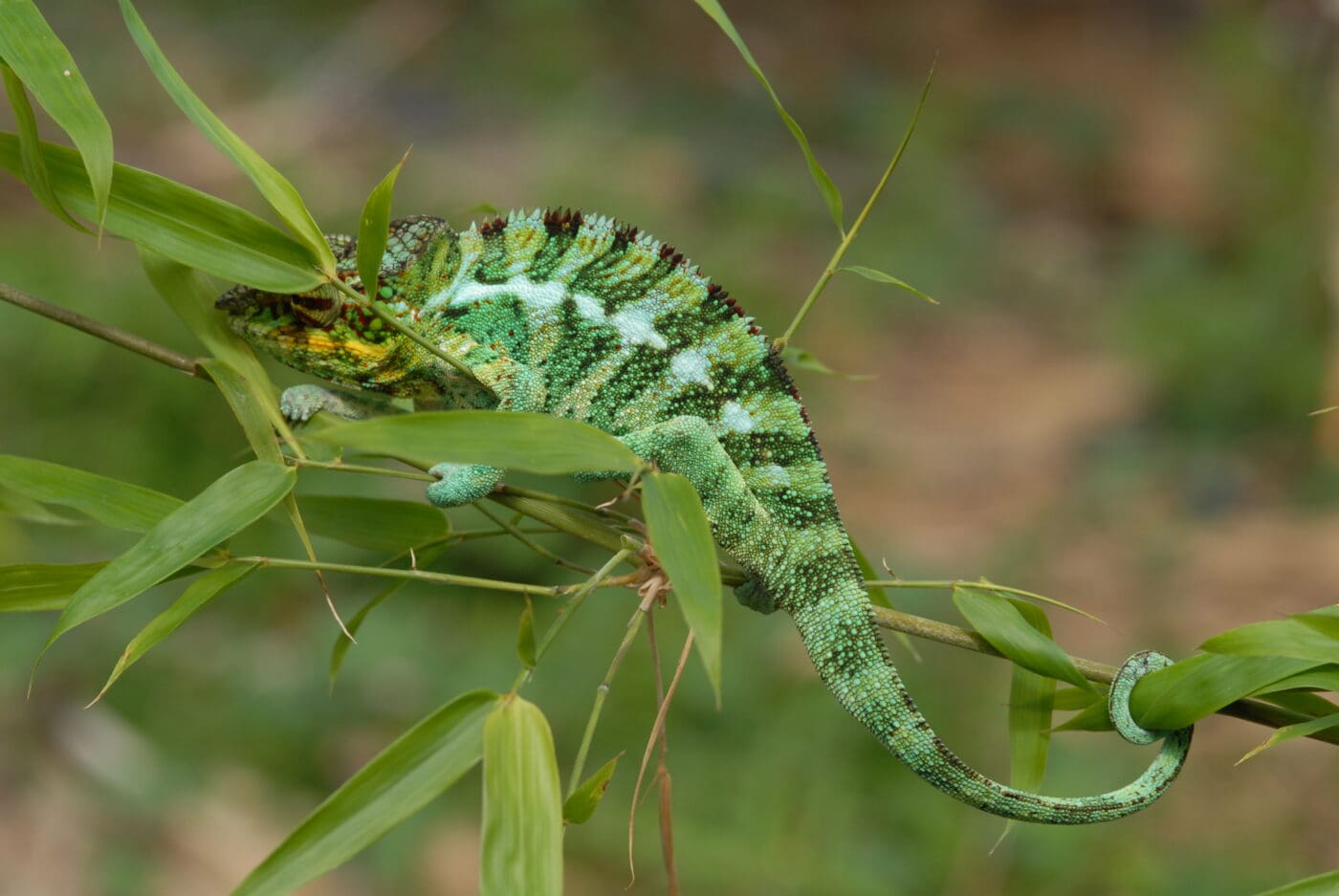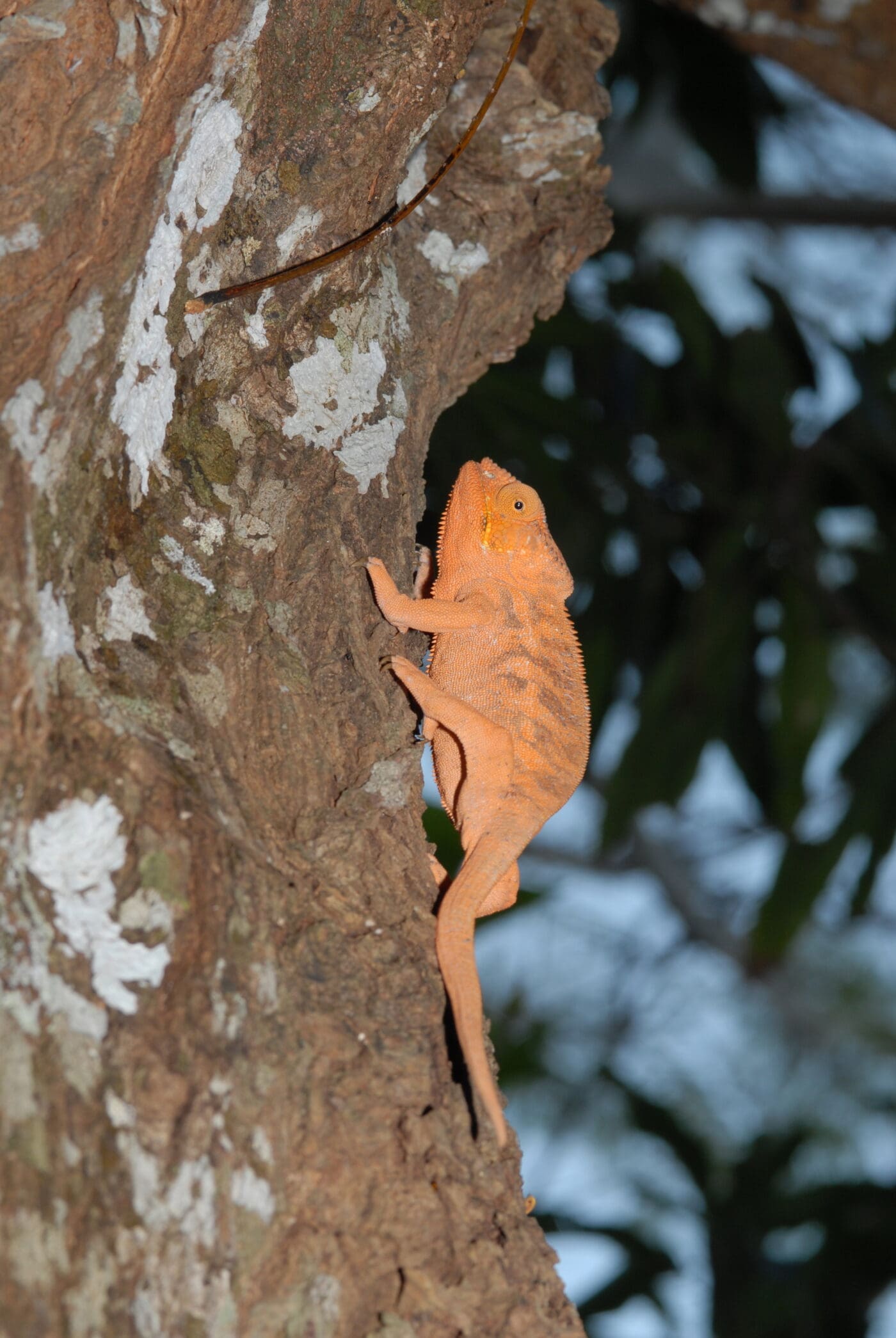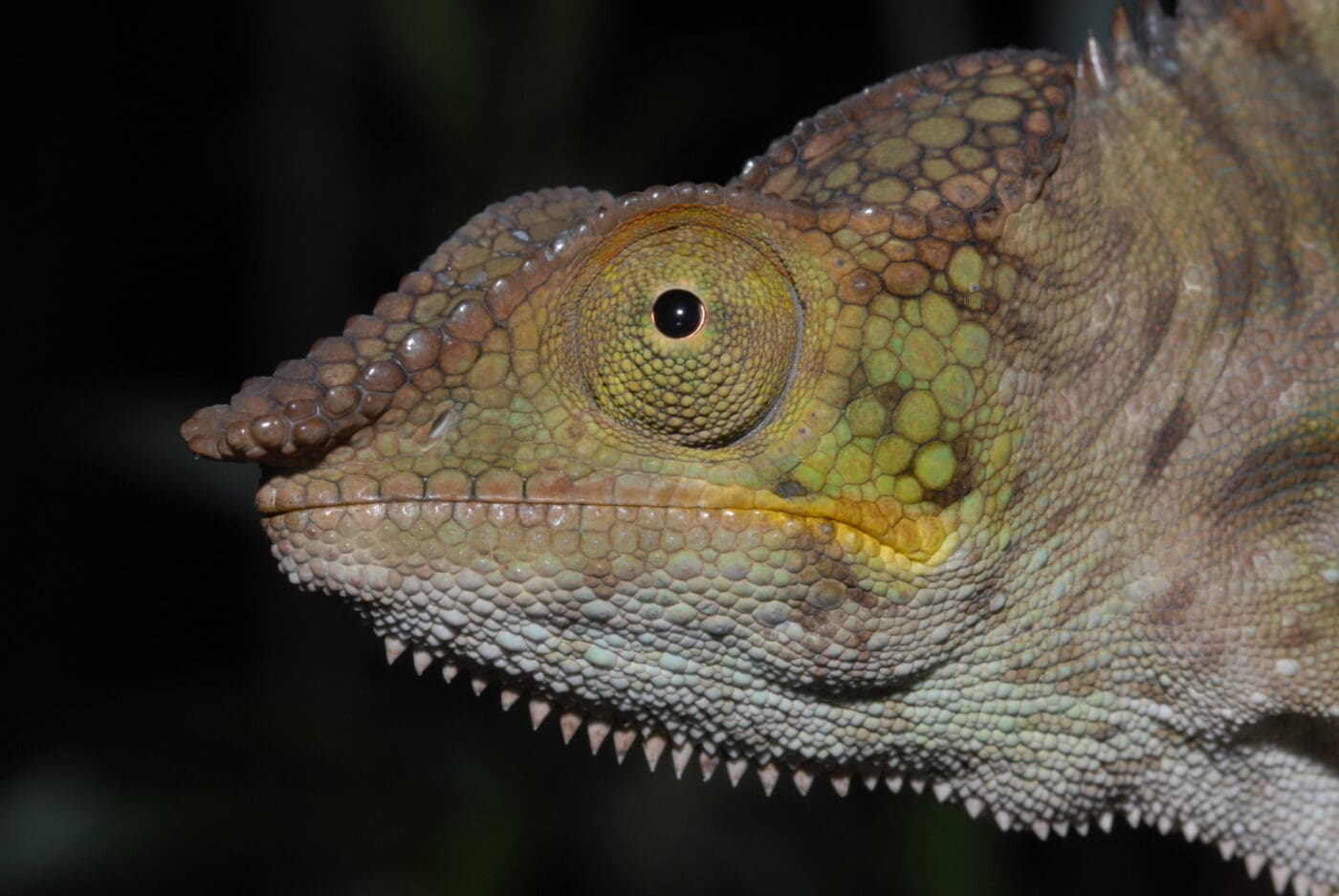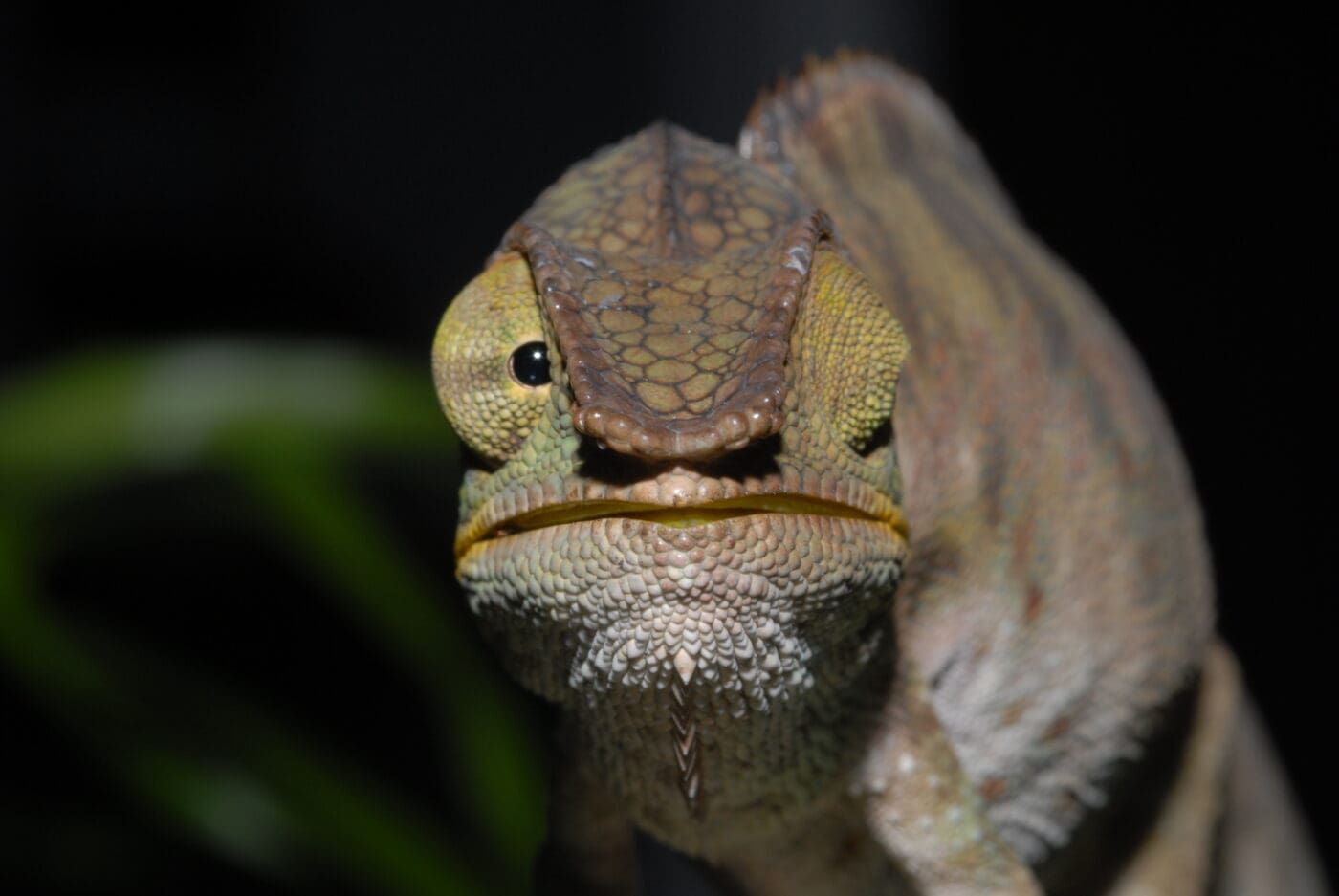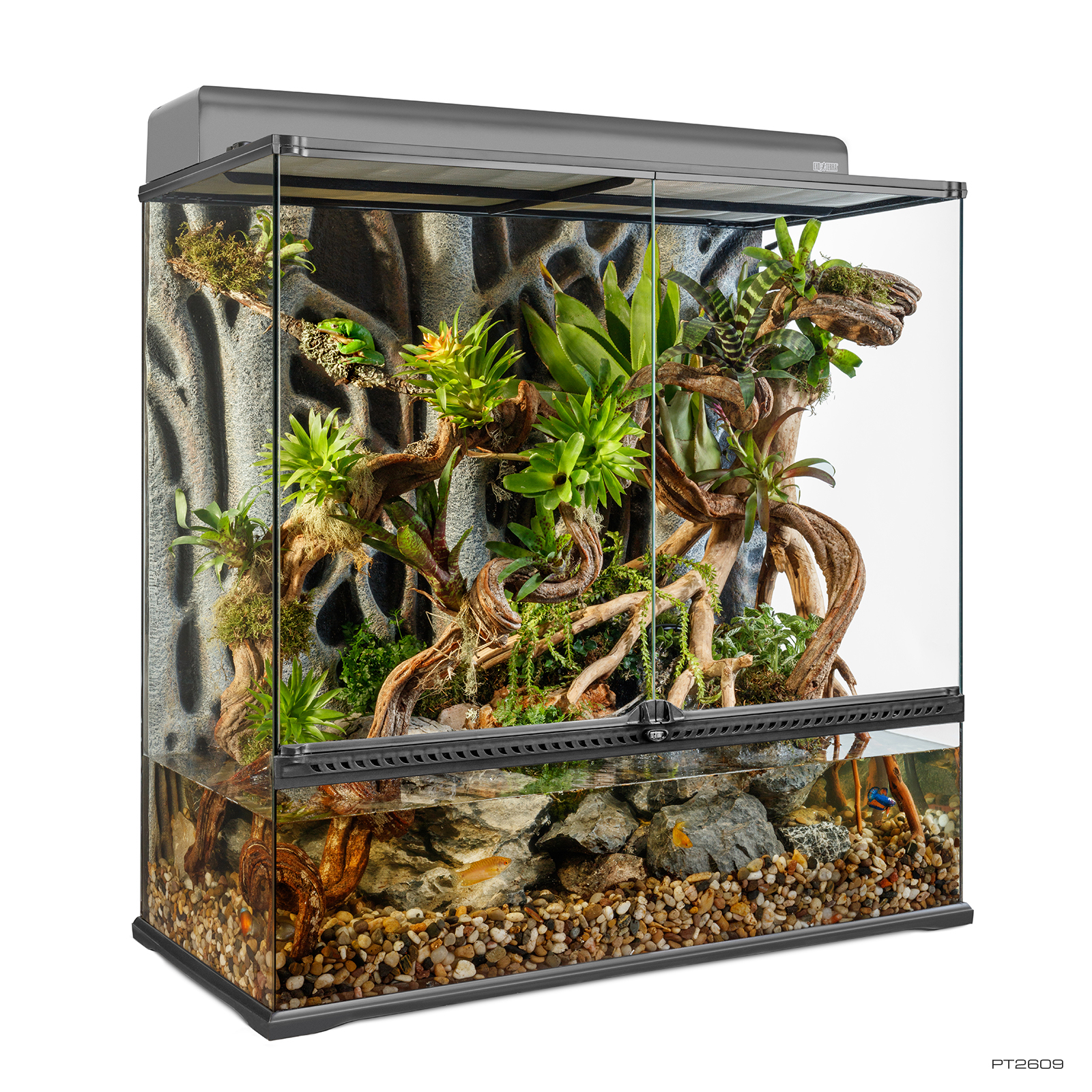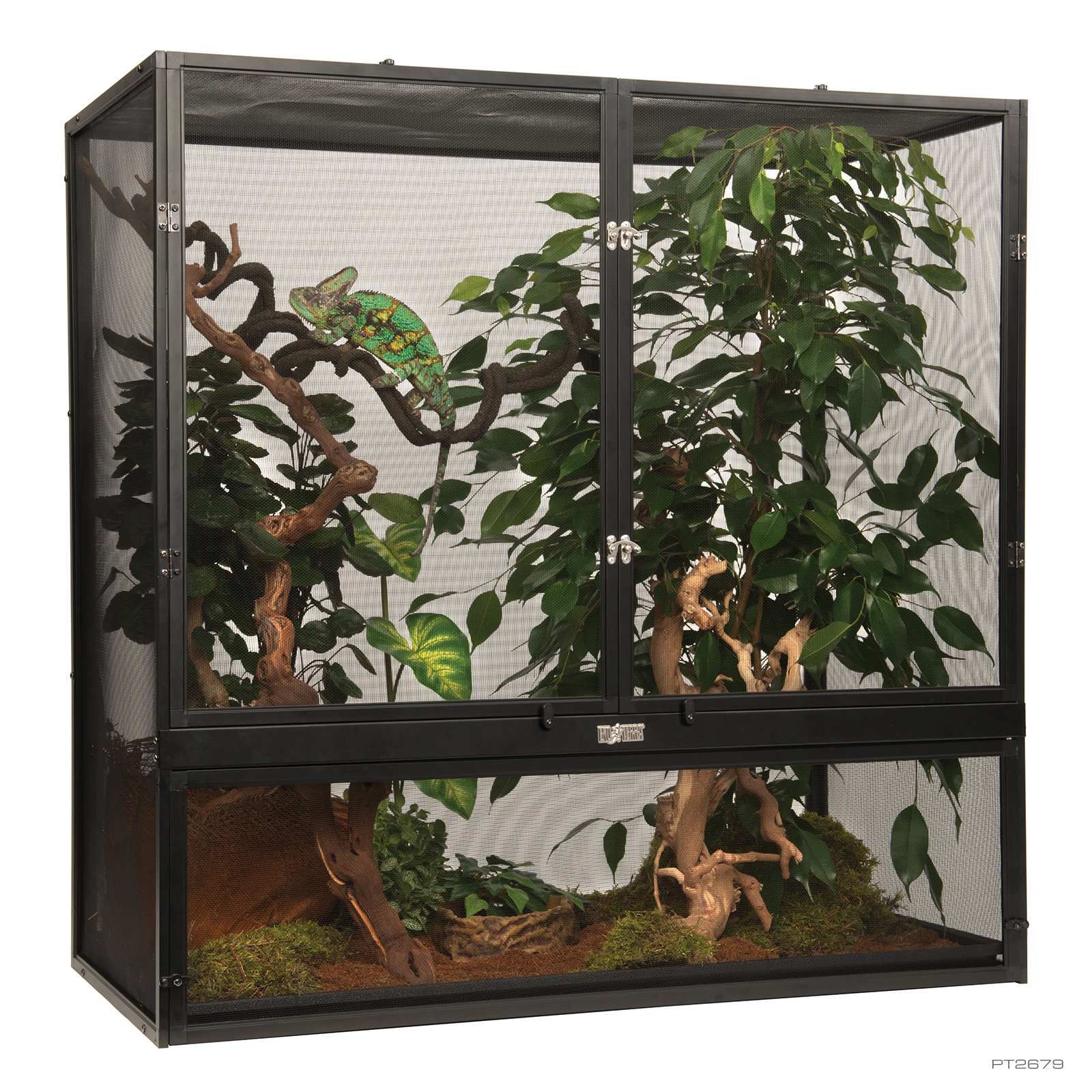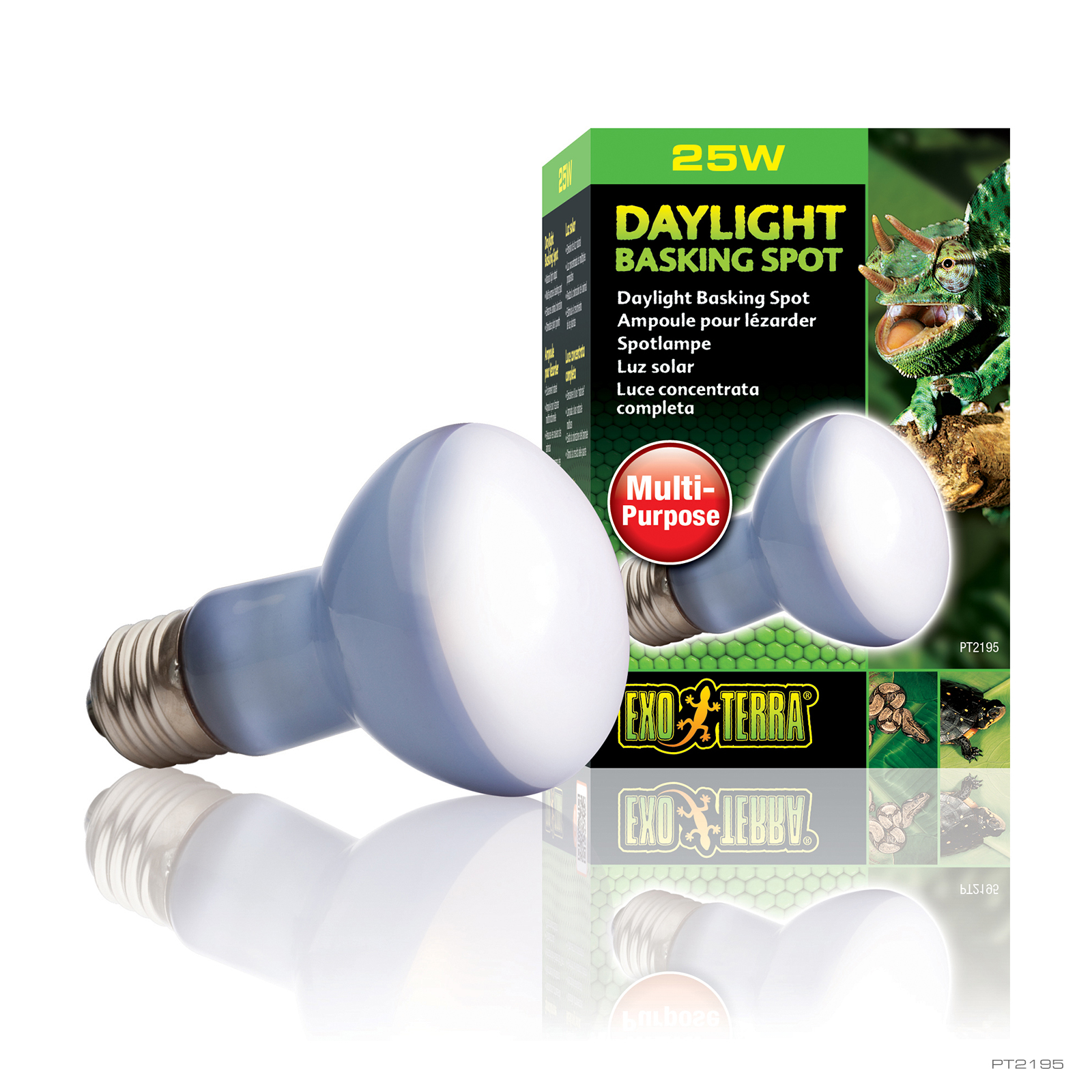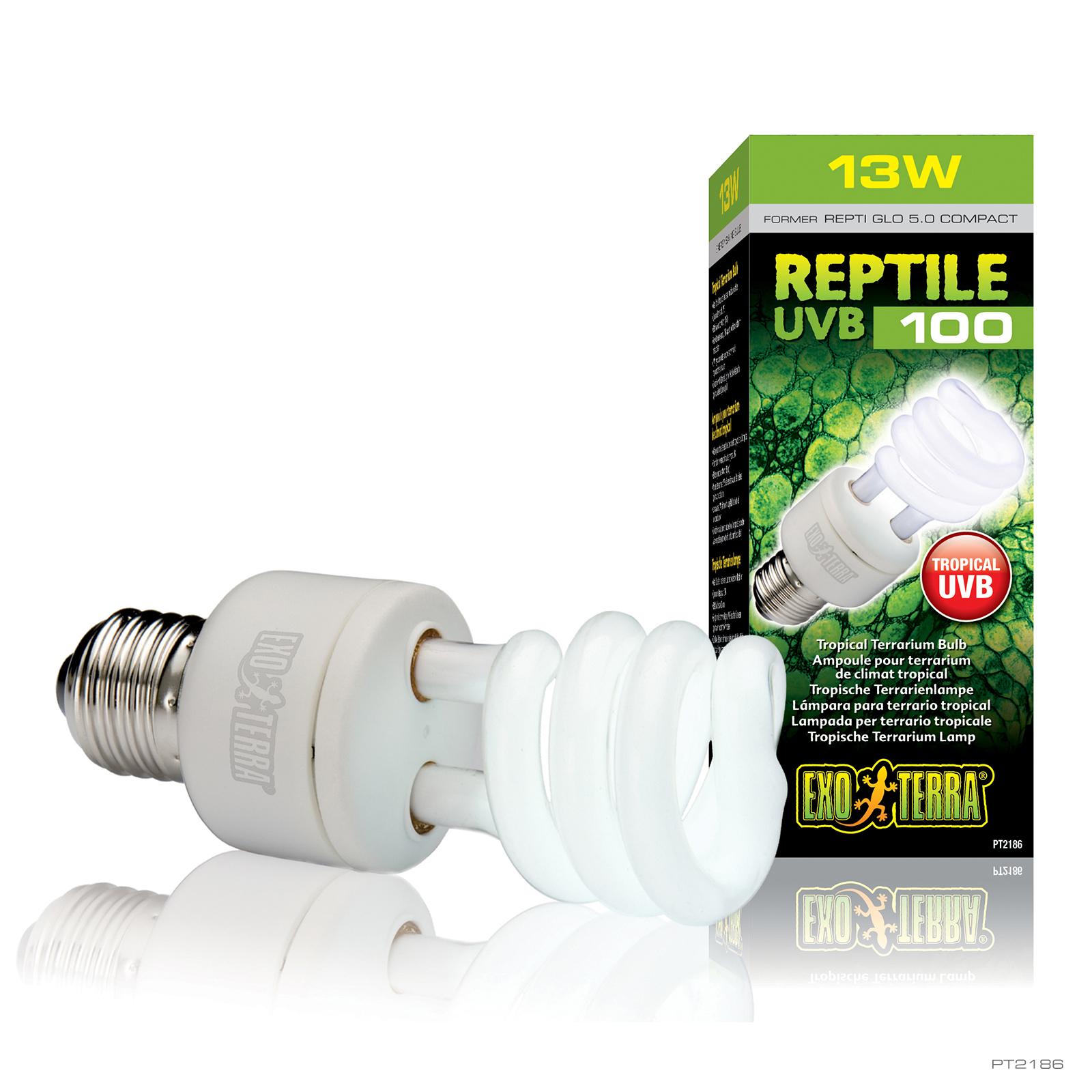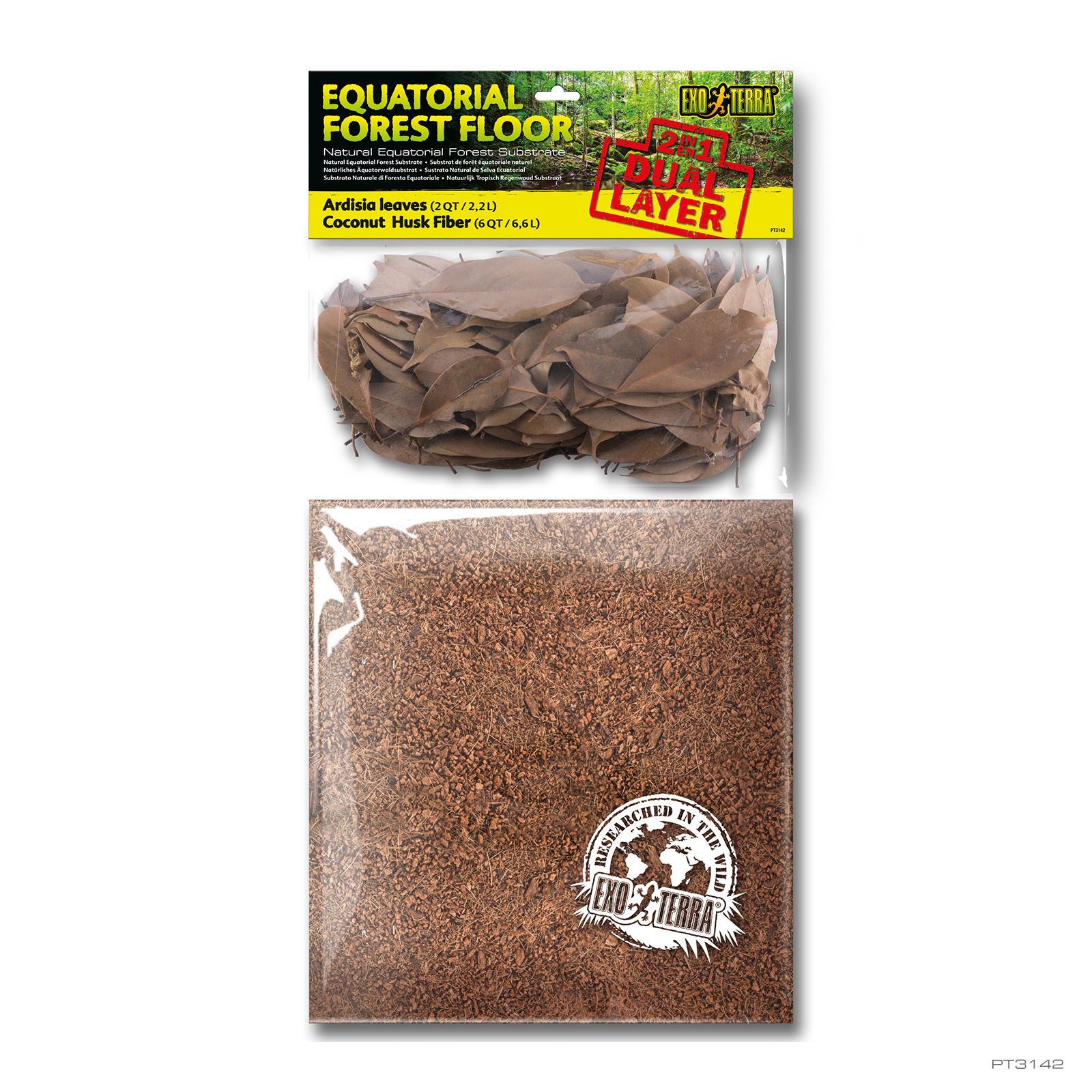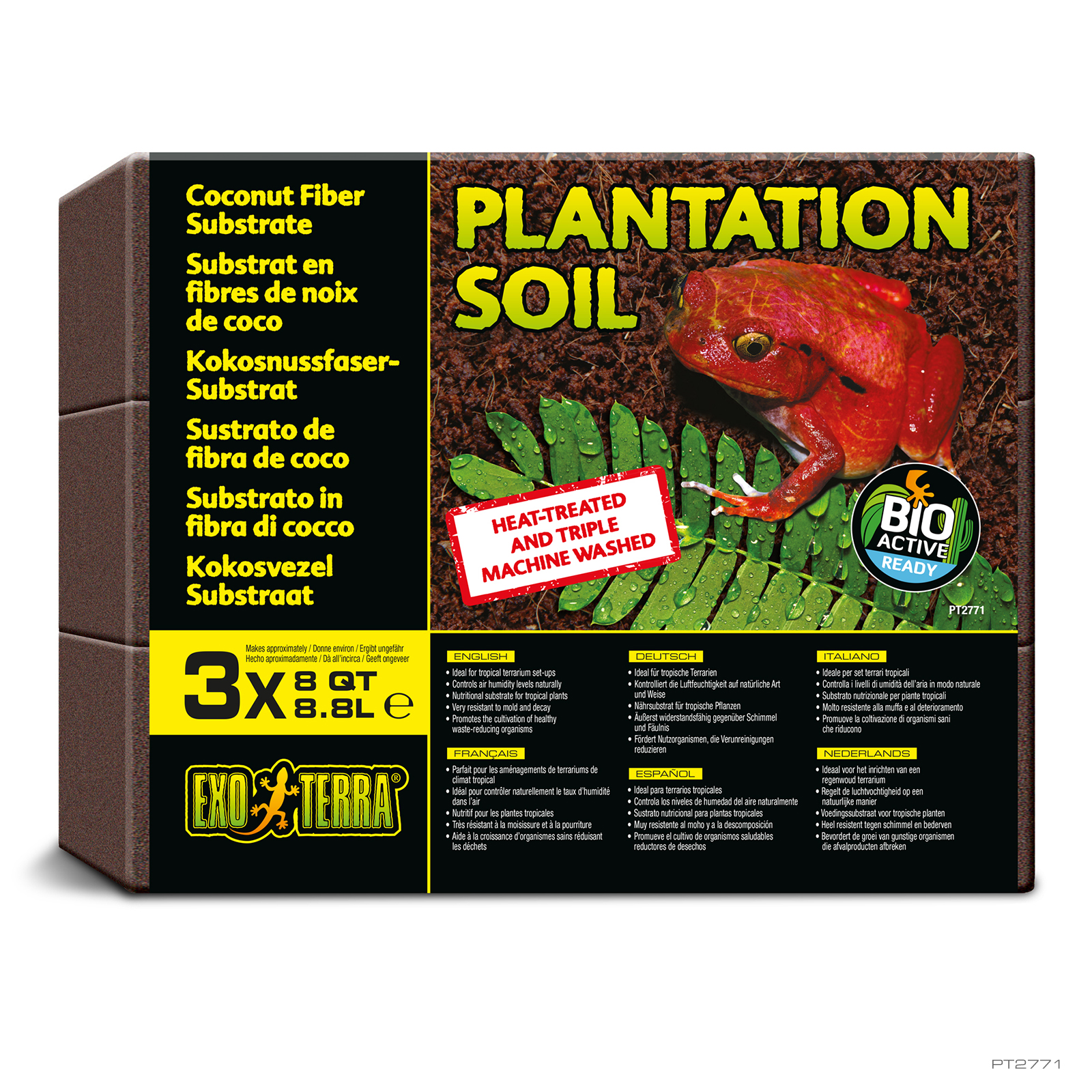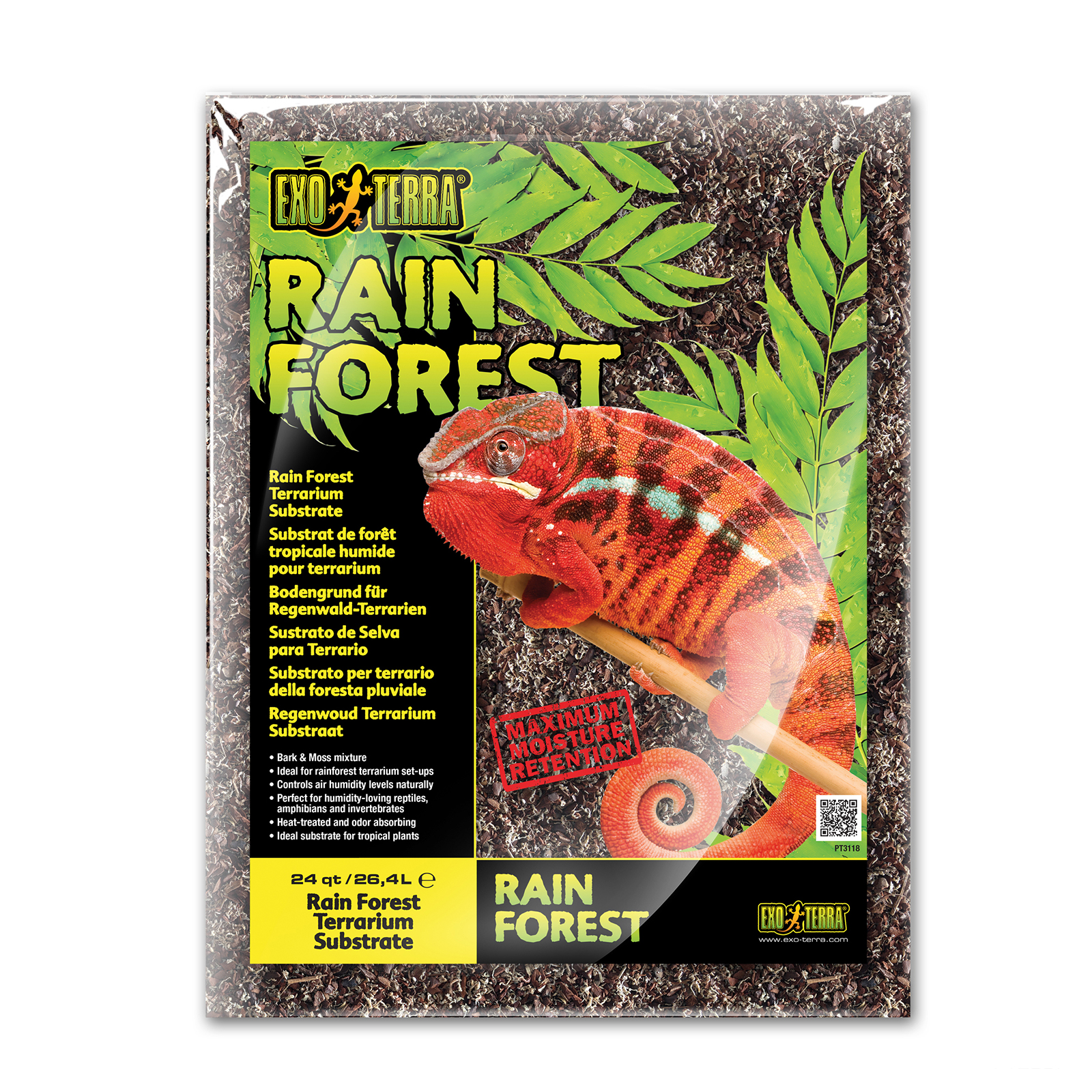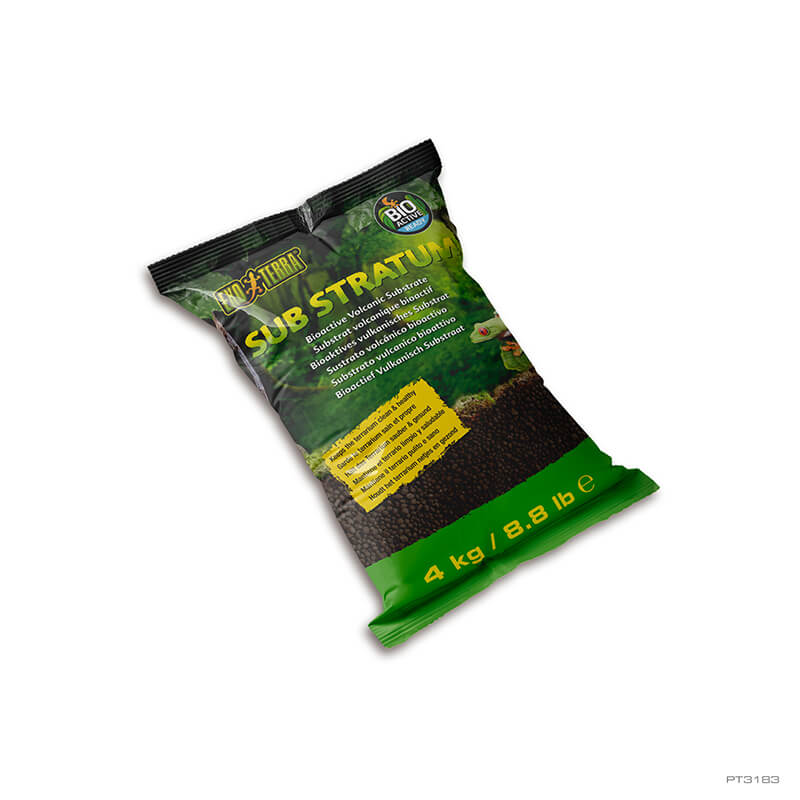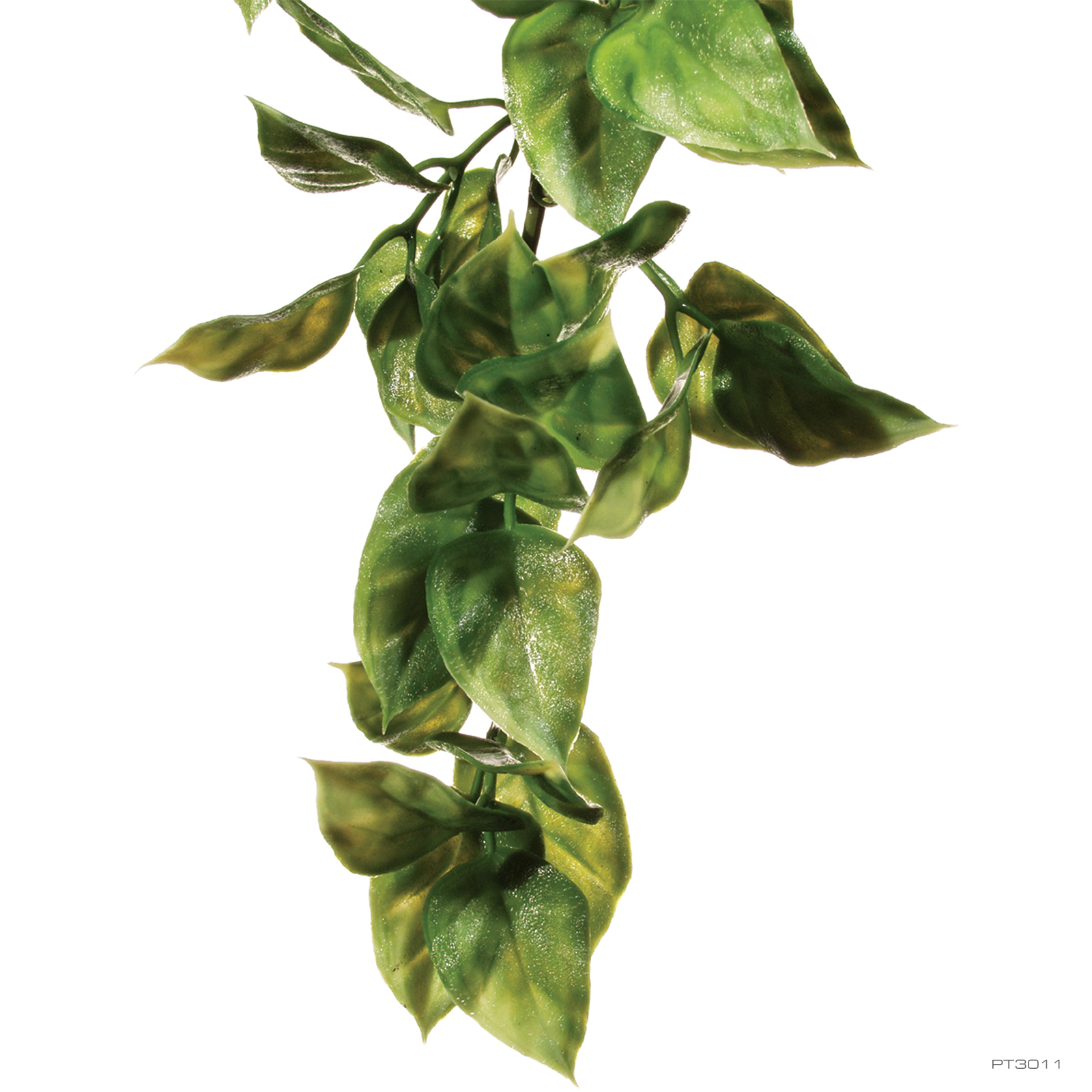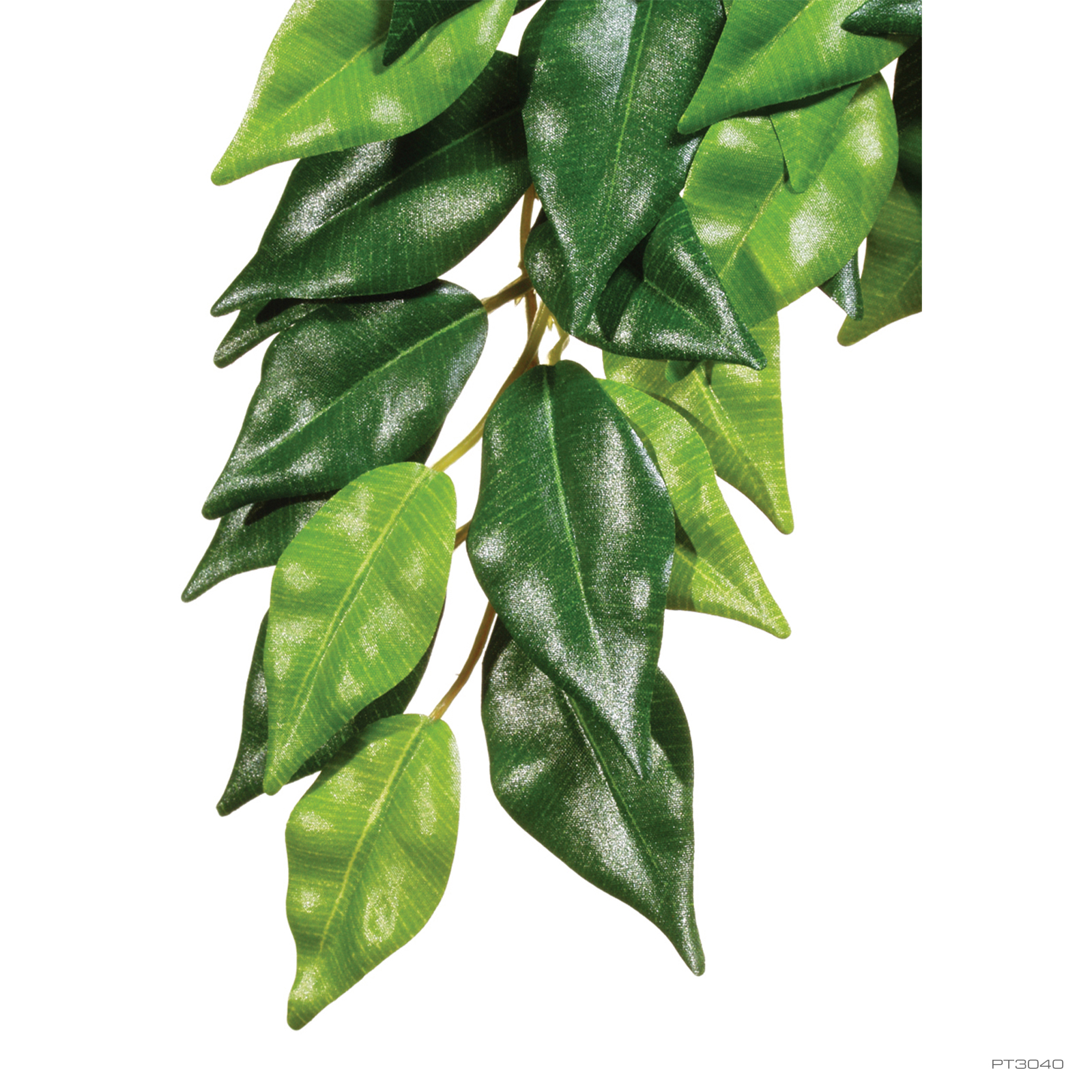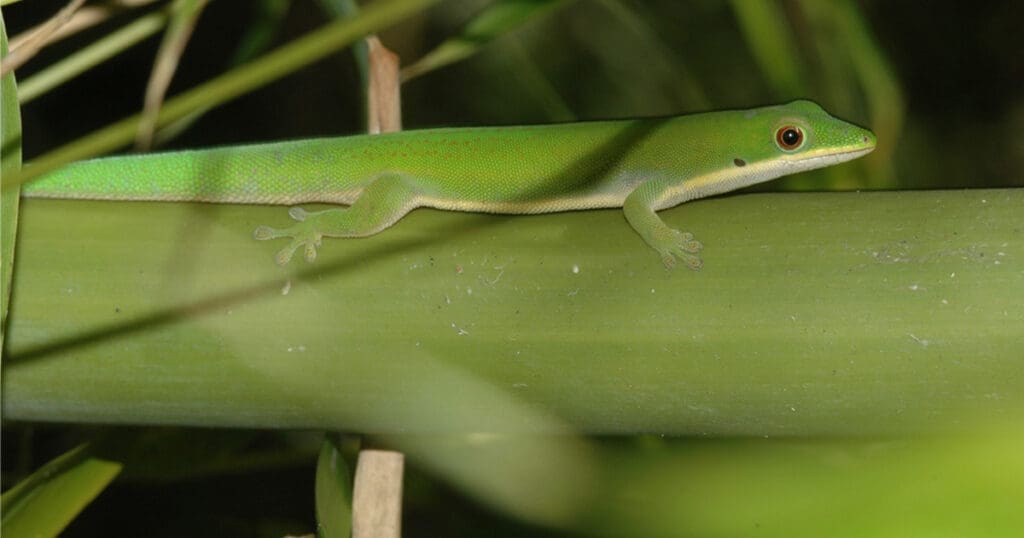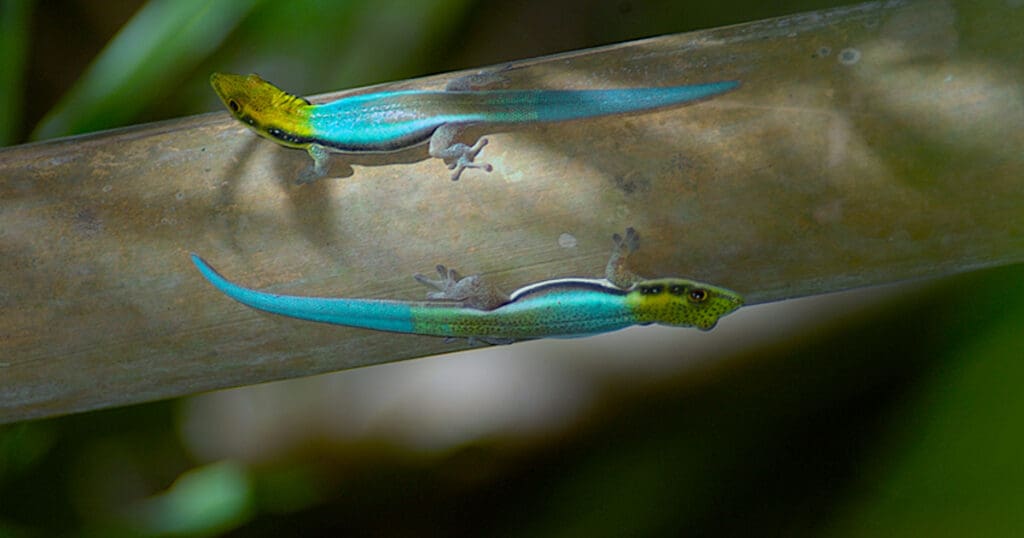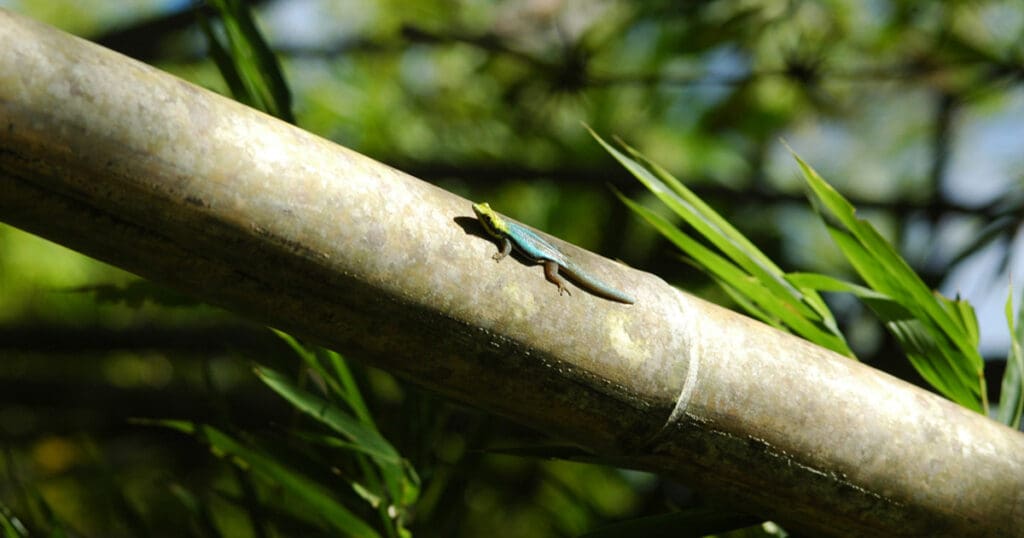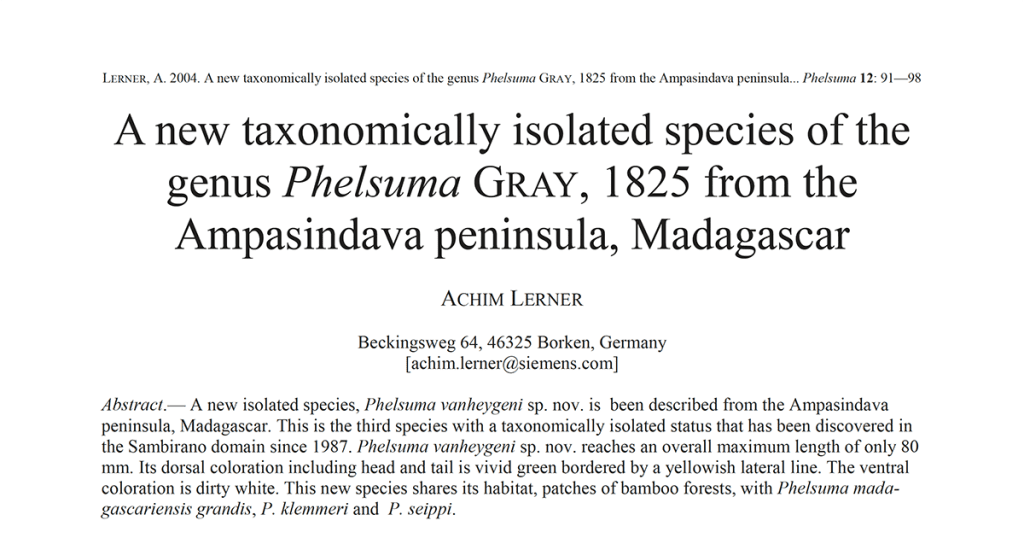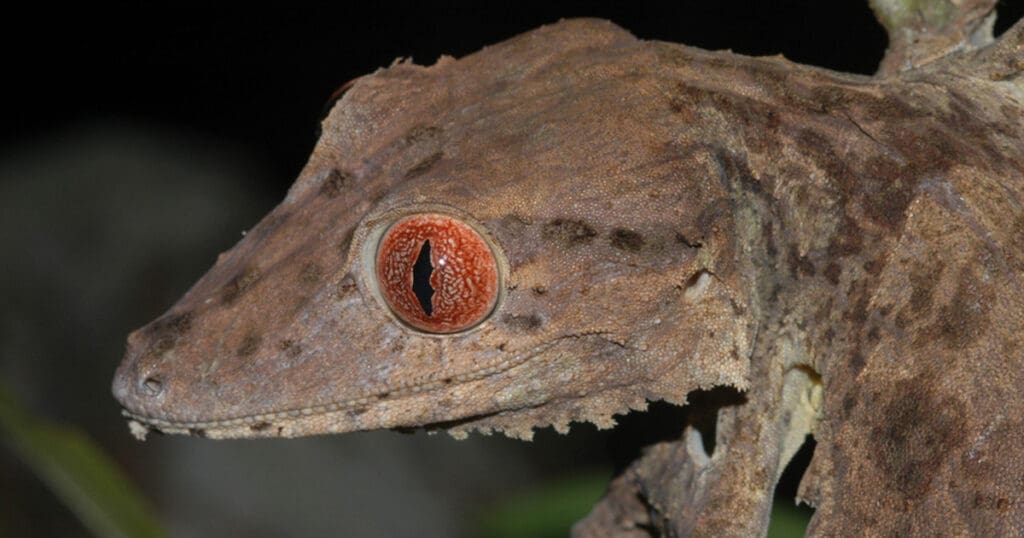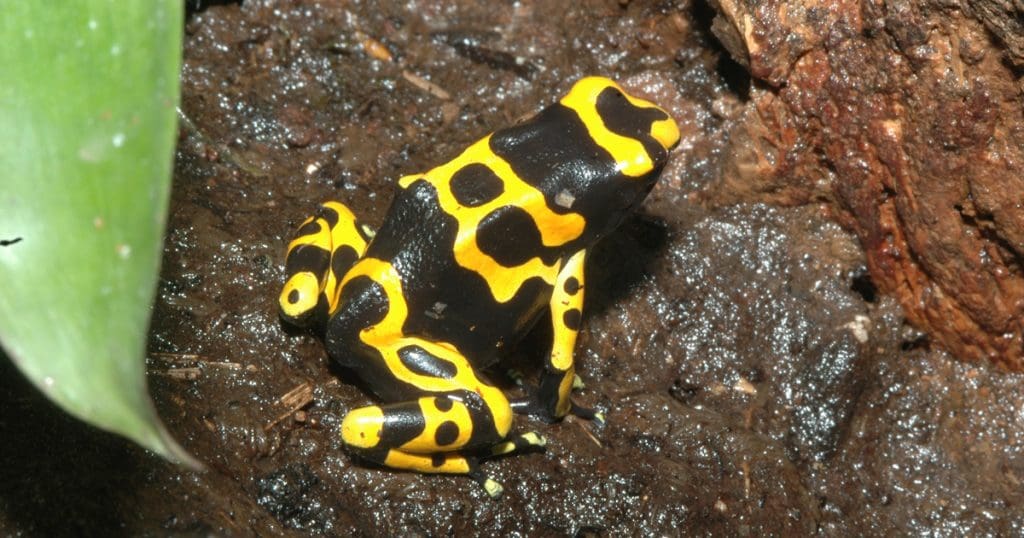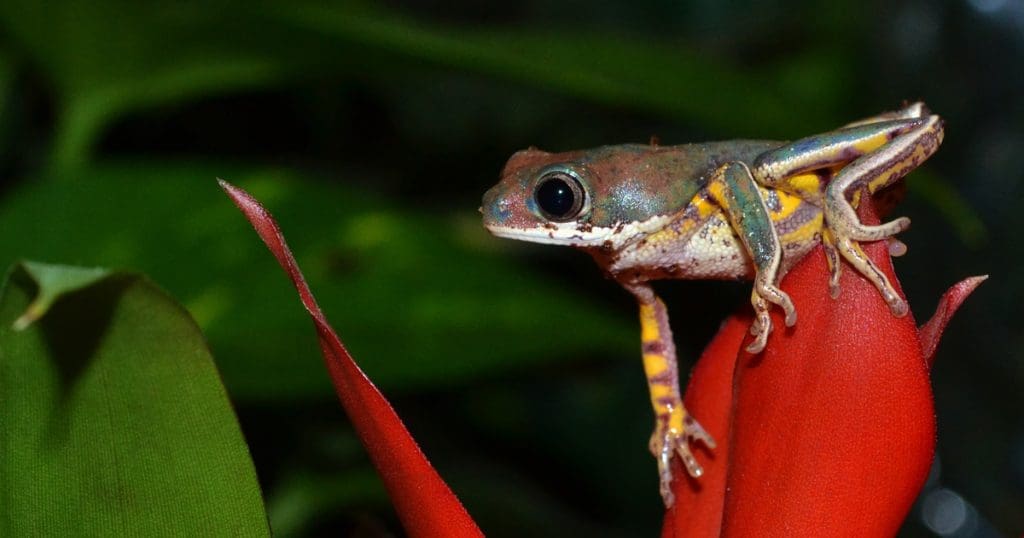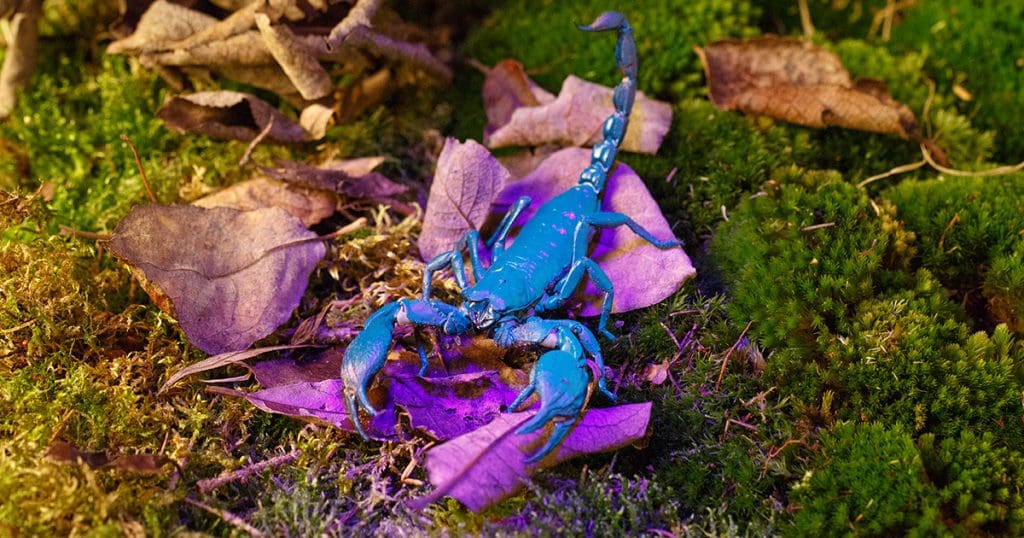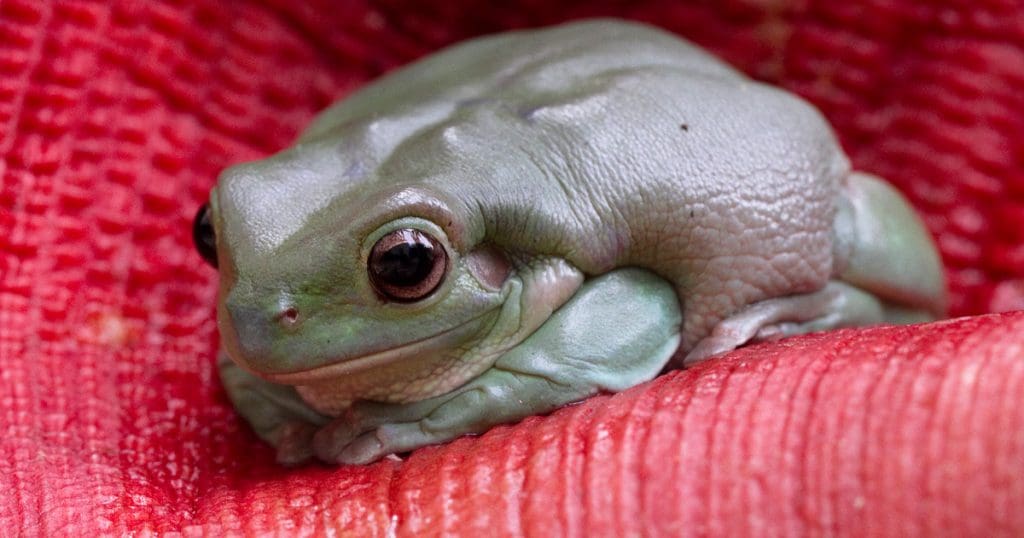
Furcifer pardalis
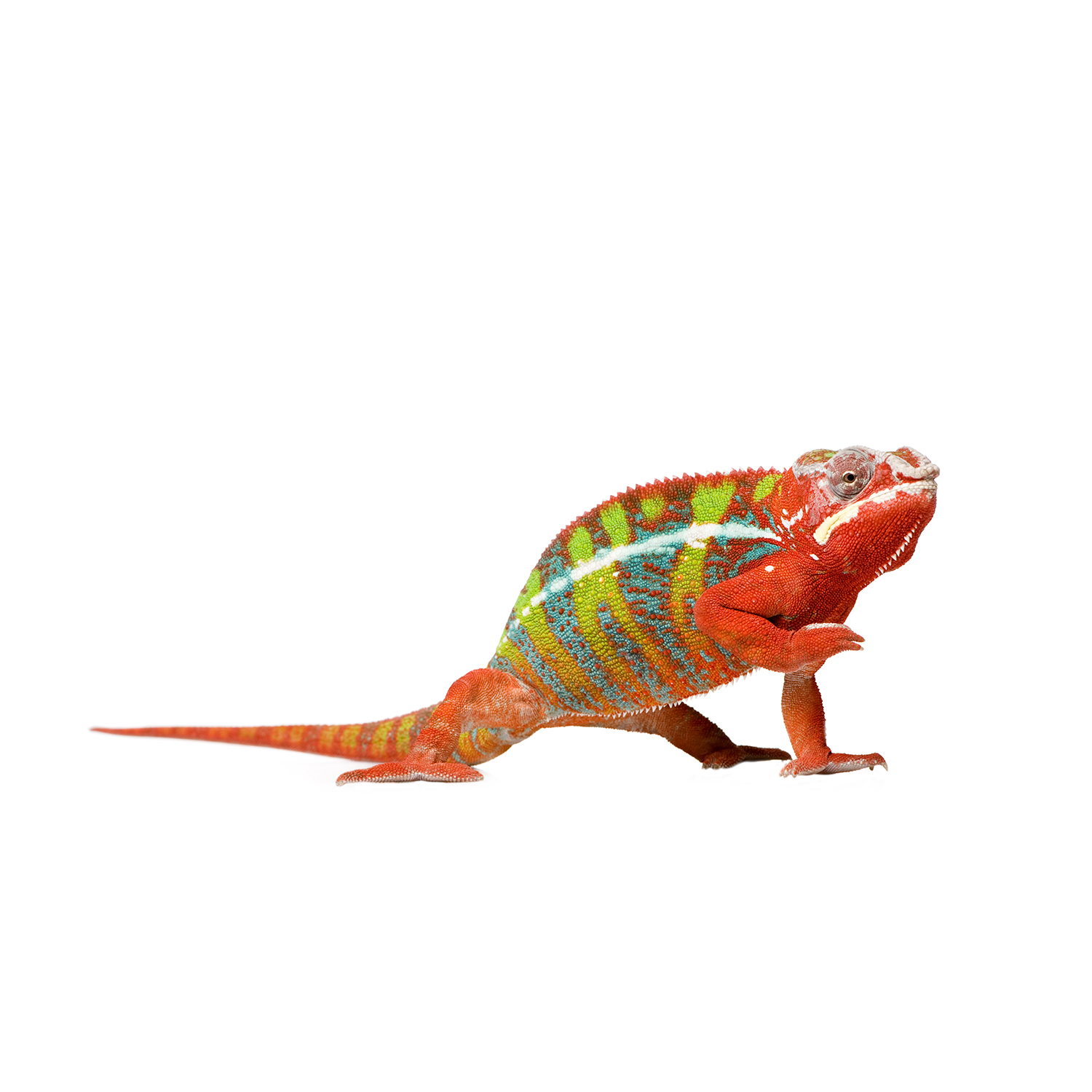

Panther Chameleon
Panther Chameleons are native to Madagascar, but have also been introduced to Réunion Island somewhere between 1750 and 1836. They were first brought to Réunion by sailors who left them at the landing port of the island during that era, which was in the vicinity of Saint Paul. The Panther Chameleons thrived and over time, they spread to various parts of the Island. There have also been sightings of Furcifer pardalis on Mauritius Island, but these populations are expected to have been introduced quite recently.
They primarily prefer warm and humid lowland coastal forests, rainforest canopies, secondary forests, plantations and hotel or home gardens and planted fences.
Panther Chameleons belong to the family Chamaeleonidae in the Genus Furcifer.
Panther Chameleons have the typical chameleon characteristics such as the vertically flattened body, the prehensile tail, the pincer-like grasping feet, the independently movable eyes, the extremely long projecting tongue and of course the possibility to change color.
Chameleons can expand their body to show a more rounded body shape or compress it to become rather flattened. This helps them to navigate through the vegetation, but the main purpose of this ability is a means of communication. By flattening their body and showing it sideways to the opponent they try to look larger and fiercer. This can be used to scare off a predator, but also to impress another male entering the territory. This feature is also used for thermoregulation, as through flattening, they expose a wider area of the body to sun rays.
Chameleons are perfectly adapted to their arboreal lifestyle. Their prehensile tail helps them balance while walking on the thin branches of the vegetation that they live on. The tail can also be used to hold onto a branch, while at the same time they firmly grasp the branch with their pincer-like grasping feet. The Chameleon's front feet have 2 merged digits on the outside and 3 on the inside, while on their hind feet it is vice versa. This specific composition of their digits was recently named chameleodactyly. Their grasping feet, with claws on each digit, assure a firm grip while climbing branches, even when there's very heavy winds.
The Chameleon's eyes are an extraordinary technical feature created by Mother Nature. The eyes are completely covered by a muscular eyelid except for a pinhole opening that exposes the pupil. Due to the unique anatomy of the eyes, they're able to rotate the eyes in an almost 180° angle independently from each other, focusing on 2 totally different directions, providing the Chameleon with a nearly 360° view. The Chameleon can switch between monocular vision to binocular vision whenever needed. When 1 eye notices a prey insect, the Chameleon immediately uses his second eye to switch to binocular view in order to increase the depth perception. With this binocular vision, the Chameleon can estimate the exact distance to the prey insect, and here comes another piece of Mother Nature's ingenuity into play, the Chameleon's projectile tongue.
The Chameleon's tongue is actually kind of a tubular muscle that is retracted over the hyoid horn while at rest. Three major contributors make the tongue mechanics work; the retractor muscle has a dual function and keeps the tongue in place over the hyoid horn while in rest, but also retracts the tongue once the prey insect has been caught. The accelerator muscle is responsible for projecting the tongue at an enormous speed towards the insect, fast enough to catch a fly in midair. And last but not least, the sticky tongue's viscous adhesive property is strong enough to pick up prey insects with a weight of up to 30% of the Chameleons own body mass. The viscosity of the mucus on the Chameleon tongue is about 1000 times stickier than human mucus (Prof. Pascal Damman of the University of Mons, Belgium). According to Dr. Schwenk of the University of Connecticut there's also a lingual suction cup effect at play, which strengthens the grip on the prey insect when the prey is dangling while the tongue is 'reeled' back into the mouth.
Ever since Aristotle himself, the forefather of Western philosophy and keen zoologist, described the color change in Chameleons in his Historia Animalium in 350 BC, people have been fascinated by the Chameleon's ability to rapidly change color.
The Chameleon's skin contains various layers that all contribute to the color changing ability.
The color changes are a combined effort of the melanin filled black color Chromatophores, the Melanophores, and the Iridophores containing crystals of Guanine. While the Melanophores provide dark and light shades of the body from white to black, the Iridophore Chromatophores are responsible for most of the color adjustment by determining the reflection of light. Iridiphores contain tiny guanine crystals which adjust the way they reflect light depending upon the spacing between the individual nanocrystals and using the two independently above each layer of guanine. By relaxing or stretching the Chameleons skin, the distance between the nanocrystals varies and changes the reflection of the light which is then perceived as a color. The color blue for instance, is formed when the skin is in a relaxed state because the nanocrystals are very close to each other and they reflect short wavelength light. However, when this blue color passes the yellow color reflected by the upper layer, humans will perceive the Chameleon's color as green. When the skin becomes excited, like for instance when meeting a rival male, or a potential mating partner, the distance between neighbouring nanocrystals increases, reflecting longer wavelength light forming yellow, orange or red color (Prof. Michel Milinkovitch of the University of Geneva, Switzerland). The color changes are not primarily meant for camouflage, but rather as a means of communication during social interactions. The changes also aid in thermoregulation and signal the health and physiological state of the animals.
Panther Chameleons are one of the most colorful Chameleons available in the hobby.
Panther Chameleons show sexual dimorphism in both dimension and coloring. Males tend to grow a lot bigger than females and can reach up to 20" or 50cm in length, whereas females mostly grow to about 8 - 10" or 20-25cm in length. Adult males also show a shovel-like rostral projection on their nose and their dorsal and gular crests are more prominent in size and color compared to those of their female counterparts. Males can also be recognised by the hemipenal bulge at the base of their tails.
Most females show a soft peachy, rose to brown base color although some females show a more greyish base. Individual differences depending on locality are blueish, green or orange accents, mainly on the cheeks. The females also show an intermitted dorsolateral, mostly pinkish, cream or orange, sometimes white stripe starting at the shoulders towards the tail base. If a female is non-receptive towards males, their base color intensifies, the vertical bands get darker and the contrast with the orange base color is increased.
It is almost impossible to describe the color of Panther Chameleon males in general, as the color palette available to these chameleons is enormous and the composition of the colors varies greatly between the different localities where these chameleons occur. The base color can vary between grey, turquoise, red, orange, pink, yellow and green depending on the locality. All males show a mostly white, dorsolateral stripe that runs from the shoulder to the tail base and 5 vertical darker colored bands on the body, continuing in the form of rings over the legs and tail.
Since the Panther Chameleon has a widespread distribution, the males evolved into various local color forms. And even the local forms vary somewhat in composition, but we will try to provide you an overview describing the most common color compositions:
Ambanja: the Ambanja is a very colorful local form with a base color consisting of a mixture of blueish-green and yellow, with orange and red accents on body and head. The vertical bands on the body can be speckled with a strong dark blue to almost purple.
Ambilobe: another colorful local form is the Ambilobe, but this morph has a more green and yellow base with lots of red on the head, limbs and tail. The vertical bands on the body can show red or blue, or a mixture of both, depending on the specimen.
Ankaramy: the base color of the so-called Pink Panther morph is a pink to reddish pink with turquoise accents on the head and dorsal crest.
Diego Suarez: a very vivid green with yellow, is the base color of the Diego Suarez form, with red accents on the eyelids, throat, the vertical bands on the body as well as the rings on the tail and limbs.
Maroantsetra: the Maroantsetra form has a green base-color with red and yellow accents on the head, body, limbs and tail. The lips and some spots around the throat and front legs are white.
Nosy Be: the base color of the Nosy Be form is a blueish-green to turquoise. There's a variation in red and yellow accents on the cheeks and lips, depending on the specimen. Some individuals even show red speckles all over their body, depending on their mood.
Nosy Boraha: the Nosy Boraha form shows a greyish base color with yellow lips and blueish, sometimes reddish, accents on body and head.
Réunion: the color form from La Réunion is very comparable to the Nosy Be form, although the Réunion females show more blue accents, especially on the head and cheeks.
Sambava: the base color of the Sambava form is a vivid green shifting to a green-yellow mix towards the belly area. The vertical bands on the body show a maroon color while the lips and dorsolateral stripe remain white. When the Sambava morph gets all fired up, they can switch their base color to almost complete yellow with some green and red, or even completely red with maroon vertical bands.
Panther Chameleons can reach sexual maturity at the young age of 8-9 months old. We do however recommend that you wait until the animals are between 12 and 14 months of age, before mating them, to ensure that the animals are physically strong enough to handle the arduous process of egg development and egg laying.
Ever since the Panther Chameleon was imported in Europe and the USA, starting around 1980, herpetologists and reptile breeders have worked on enhancing the captive husbandry guidelines continuously. For instance, the use of UVB lighting was a game changer and after a decade or two, the Panther Chameleon became well-established in the hobby.
Due to the hardiness, the gentle character and the striking colors, the Panther Chameleon, rapidly became a popular terrarium animal. The Panther Chameleon is currently available, as captive bred animals, in many geographic color morphs.
There's currently a wide array of captive bred, geographic color forms of the Panther Chameleon available from breeders as well as in stores and on reptile shows. There are also color morphs available that have been selectively bred to increase a certain color or color combination by mixing various natural, geographic color forms. Panther Chameleons have now been captive bred in Europe and the USA for more than 30 years.

History

The Panther Chameleon was first described in 1829 as Chamaeleo pardalis by the French naturalist Baron Georges Cuvier, in his famous work "Le règne animal distribué d'après son organisation" (The Animal Kingdom Arranged in Conformity with Its Organization). Baron Cuvier erroneously described the Panther Chameleon as originating from Isle de France in Mauritius. In 1986 Klaver & Böhme shifted the Panther Chameleon from the Genus Chamaeleo into the Genus Furcifer.
The common name Chamaeleon derives from a composition of two Greek words, namely "chamai"or "crawling on the ground" and "leon" or "lion". Chameleon thus could be roughly translated as "ground lion" or "ground crawling lion", but according to the latest investigations, “hidden beast” is supposedly the more correct translation.
The Genus Furcifer derives its name from a Latin word, namely "furca" or "forked" referring to the fork-like nasal protrusions that many members of this genus show. The common name Panther Chameleon derives from the specific epithet "pardalis", which means "Panther" in Latin. The black dots on the Panther Chameleon's body, reminded Georges Cuvier of a panther's dotted fur, when he described the Chameleon.
The first record of a male Panther Chameleon kept in a Terrarium was written by Tofohr in 1908. Also, Fahr mentioned in a 1910 published report how he kept a Panther Chameleon. Both authors already pointed out that a wide variety of food items is healthy for a Chameleon. In 1971 Bourgat publishes the first captive breeding record of Furcifer pardalis.
Characteristics
Panther Chameleons belong to the family Chamaeleonidae in the Genus Furcifer.
Panther Chameleons have the typical chameleon characteristics such as the vertically flattened body, the prehensile tail, the pincer-like grasping feet, the independently movable eyes, the extremely long projecting tongue and of course the possibility to change color.
Chameleons can expand their body to show a more rounded body shape or compress it to become rather flattened. This helps them to navigate through the vegetation, but the main purpose of this ability is a means of communication. By flattening their body and showing it sideways to the opponent they try to look larger and fiercer. This can be used to scare off a predator, but also to impress another male entering the territory. This feature is also used for thermoregulation, as through flattening, they expose a wider area of the body to sun rays.
Chameleons are perfectly adapted to their arboreal lifestyle. Their prehensile tail helps them balance while walking on the thin branches of the vegetation that they live on. The tail can also be used to hold onto a branch, while at the same time they firmly grasp the branch with their pincer-like grasping feet. The Chameleon's front feet have 2 merged digits on the outside and 3 on the inside, while on their hind feet it is vice versa. This specific composition of their digits was recently named chameleodactyly. Their grasping feet, with claws on each digit, assure a firm grip while climbing branches, even when there's very heavy winds.
The Chameleon's eyes are an extraordinary technical feature created by Mother Nature. The eyes are completely covered by a muscular eyelid except for a pinhole opening that exposes the pupil. Due to the unique anatomy of the eyes, they're able to rotate the eyes in an almost 180° angle independently from each other, focusing on 2 totally different directions, providing the Chameleon with a nearly 360° view. The Chameleon can switch between monocular vision to binocular vision whenever needed. When 1 eye notices a prey insect, the Chameleon immediately uses his second eye to switch to binocular view in order to increase the depth perception. With this binocular vision, the Chameleon can estimate the exact distance to the prey insect, and here comes another piece of Mother Nature's ingenuity into play, the Chameleon's projectile tongue.
The Chameleon's tongue is actually kind of a tubular muscle that is retracted over the hyoid horn while at rest. Three major contributors make the tongue mechanics work; the retractor muscle has a dual function and keeps the tongue in place over the hyoid horn while in rest, but also retracts the tongue once the prey insect has been caught. The accelerator muscle is responsible for projecting the tongue at an enormous speed towards the insect, fast enough to catch a fly in midair. And last but not least, the sticky tongue's viscous adhesive property is strong enough to pick up prey insects with a weight of up to 30% of the Chameleons own body mass. The viscosity of the mucus on the Chameleon tongue is about 1000 times stickier than human mucus (Prof. Pascal Damman of the University of Mons, Belgium). According to Dr. Schwenk of the University of Connecticut there's also a lingual suction cup effect at play, which strengthens the grip on the prey insect when the prey is dangling while the tongue is 'reeled' back into the mouth.
Ever since Aristotle himself, the forefather of Western philosophy and keen zoologist, described the color change in Chameleons in his Historia Animalium in 350 BC, people have been fascinated by the Chameleon's ability to rapidly change color.
The Chameleon's skin contains various layers that all contribute to the color changing ability.
The color changes are a combined effort of the melanin filled black color Chromatophores, the Melanophores, and the Iridophores containing crystals of Guanine. While the Melanophores provide dark and light shades of the body from white to black, the Iridophore Chromatophores are responsible for most of the color adjustment by determining the reflection of light. Iridiphores contain tiny guanine crystals which adjust the way they reflect light depending upon the spacing between the individual nanocrystals and using the two independently above each layer of guanine. By relaxing or stretching the Chameleons skin, the distance between the nanocrystals varies and changes the reflection of the light which is then perceived as a color. The color blue for instance, is formed when the skin is in a relaxed state because the nanocrystals are very close to each other and they reflect short wavelength light. However, when this blue color passes the yellow color reflected by the upper layer, humans will perceive the Chameleon's color as green. When the skin becomes excited, like for instance when meeting a rival male, or a potential mating partner, the distance between neighbouring nanocrystals increases, reflecting longer wavelength light forming yellow, orange or red color (Prof. Michel Milinkovitch of the University of Geneva, Switzerland). The color changes are not primarily meant for camouflage, but rather as a means of communication during social interactions. The changes also aid in thermoregulation and signal the health and physiological state of the animals.
Panther Chameleons are one of the most colorful Chameleons available in the hobby.
Panther Chameleons show sexual dimorphism in both dimension and coloring. Males tend to grow a lot bigger than females and can reach up to 20" or 50cm in length, whereas females mostly grow to about 8 - 10" or 20-25cm in length. Adult males also show a shovel-like rostral projection on their nose and their dorsal and gular crests are more prominent in size and color compared to those of their female counterparts. Males can also be recognised by the hemipenal bulge at the base of their tails.
Most females show a soft peachy, rose to brown base color although some females show a more greyish base. Individual differences depending on locality are blueish, green or orange accents, mainly on the cheeks. The females also show an intermitted dorsolateral, mostly pinkish, cream or orange, sometimes white stripe starting at the shoulders towards the tail base. If a female is non-receptive towards males, their base color intensifies, the vertical bands get darker and the contrast with the orange base color is increased.
It is almost impossible to describe the color of Panther Chameleon males in general, as the color palette available to these chameleons is enormous and the composition of the colors varies greatly between the different localities where these chameleons occur. The base color can vary between grey, turquoise, red, orange, pink, yellow and green depending on the locality. All males show a mostly white, dorsolateral stripe that runs from the shoulder to the tail base and 5 vertical darker colored bands on the body, continuing in the form of rings over the legs and tail.
Since the Panther Chameleon has a widespread distribution, the males evolved into various local color forms. And even the local forms vary somewhat in composition, but we will try to provide you an overview describing the most common color compositions:
Ambanja: the Ambanja is a very colorful local form with a base color consisting of a mixture of blueish-green and yellow, with orange and red accents on body and head. The vertical bands on the body can be speckled with a strong dark blue to almost purple.
Ambilobe: another colorful local form is the Ambilobe, but this morph has a more green and yellow base with lots of red on the head, limbs and tail. The vertical bands on the body can show red or blue, or a mixture of both, depending on the specimen.
Ankaramy: the base color of the so-called Pink Panther morph is a pink to reddish pink with turquoise accents on the head and dorsal crest.
Diego Suarez: a very vivid green with yellow, is the base color of the Diego Suarez form, with red accents on the eyelids, throat, the vertical bands on the body as well as the rings on the tail and limbs.
Maroantsetra: the Maroantsetra form has a green base-color with red and yellow accents on the head, body, limbs and tail. The lips and some spots around the throat and front legs are white.
Nosy Be: the base color of the Nosy Be form is a blueish-green to turquoise. There's a variation in red and yellow accents on the cheeks and lips, depending on the specimen. Some individuals even show red speckles all over their body, depending on their mood.
Nosy Boraha: the Nosy Boraha form shows a greyish base color with yellow lips and blueish, sometimes reddish, accents on body and head.
Réunion: the color form from La Réunion is very comparable to the Nosy Be form, although the Réunion females show more blue accents, especially on the head and cheeks.
Sambava: the base color of the Sambava form is a vivid green shifting to a green-yellow mix towards the belly area. The vertical bands on the body show a maroon color while the lips and dorsolateral stripe remain white. When the Sambava morph gets all fired up, they can switch their base color to almost complete yellow with some green and red, or even completely red with maroon vertical bands.
Panther Chameleons can reach sexual maturity at the young age of 8-9 months old. We do however recommend that you wait until the animals are between 12 and 14 months of age, before mating them, to ensure that the animals are physically strong enough to handle the arduous process of egg development and egg laying.
Distribution
Panther Chameleons are endemic to Northern and North-Eastern part of Madagascar and its neighbouring Islands, Nosy Bé, Nosy Mangabe, Nosy Boraha, Nosy Faly, Nosy Mitsio, Nosy Sakatia, Nosy Komba and Nosy Tanikely. Panther Chameleons were also introduced to Réunion Island and Mauritius by humans somewhere around the 1800s.
In the Wild
Panther Chameleons are diurnal reptiles with a mostly arboreal lifestyle. Chameleons are perfectly adapted to their arboreal lifestyle. Their prehensile tail and chameleodactylous feet assure that they can forage in the vegetation without the risk of falling.
Panther Chameleons primarily prefer warm and humid lowland coastal forests, rainforest canopies, secondary forests, plantations and hotel or home gardens and planted fences. They have no specific biotope so you can find them everywhere from rainforest to secondary vegetation like bushes, trees, palm trees, vanilla- Ylang-Ylang - Cacao & coffee plantations and even electric wires & garden fencing.
There are 2 distinct seasons in the Panther Chameleon's environment, a rather long rainy season from November through March and a dry season for the rest of the year. With an annual precipitation of approximately 2000 mm, even the dry season is still pretty humid, except for maybe a few weeks when there's hardly any rainfall. Average humidity during the daytime is around 70-75% in de rainy season and around 60-65% during the relative dry season.
Temperatures fluctuate only slightly during the year, with averages between 75-82°F or 24-28°C with the coldest months being May through August showing average temperatures of 72-79°F or 22-26°C. The average nighttime drop is around 10°F or 6°C but during the winter months of June, July and August, the nighttime temperatures can even fall as low as 64°F or 18°C.
Mating usually takes place during the rainy season, and after a gestation period of about 5-6 weeks, the female deposits her 20-30 eggs.

In the Terrarium
Panther Chameleons are diurnal reptiles with a primarily arboreal lifestyle and will only descend to the ground for feeding, egg-laying and under certain conditions to find hide-outs. For this reason, they require tall terrariums to accommodate plants and climbing structures. Taller terrariums will also allow for more stratification to enrich the environment and create a visually more appealing display.
Panther Chameleons are solitary creatures and we recommend to house them individually, except for brief breeding introductions. Male Panther Chameleons are highly territorial and aggressive towards other males, but will also cause stress to females due to their relentless mating behavior. Females are more tolerant of one another if kept in large enough enclosures, but even then, territorial behaviour might occur, especially if one of the females becomes pregnant.
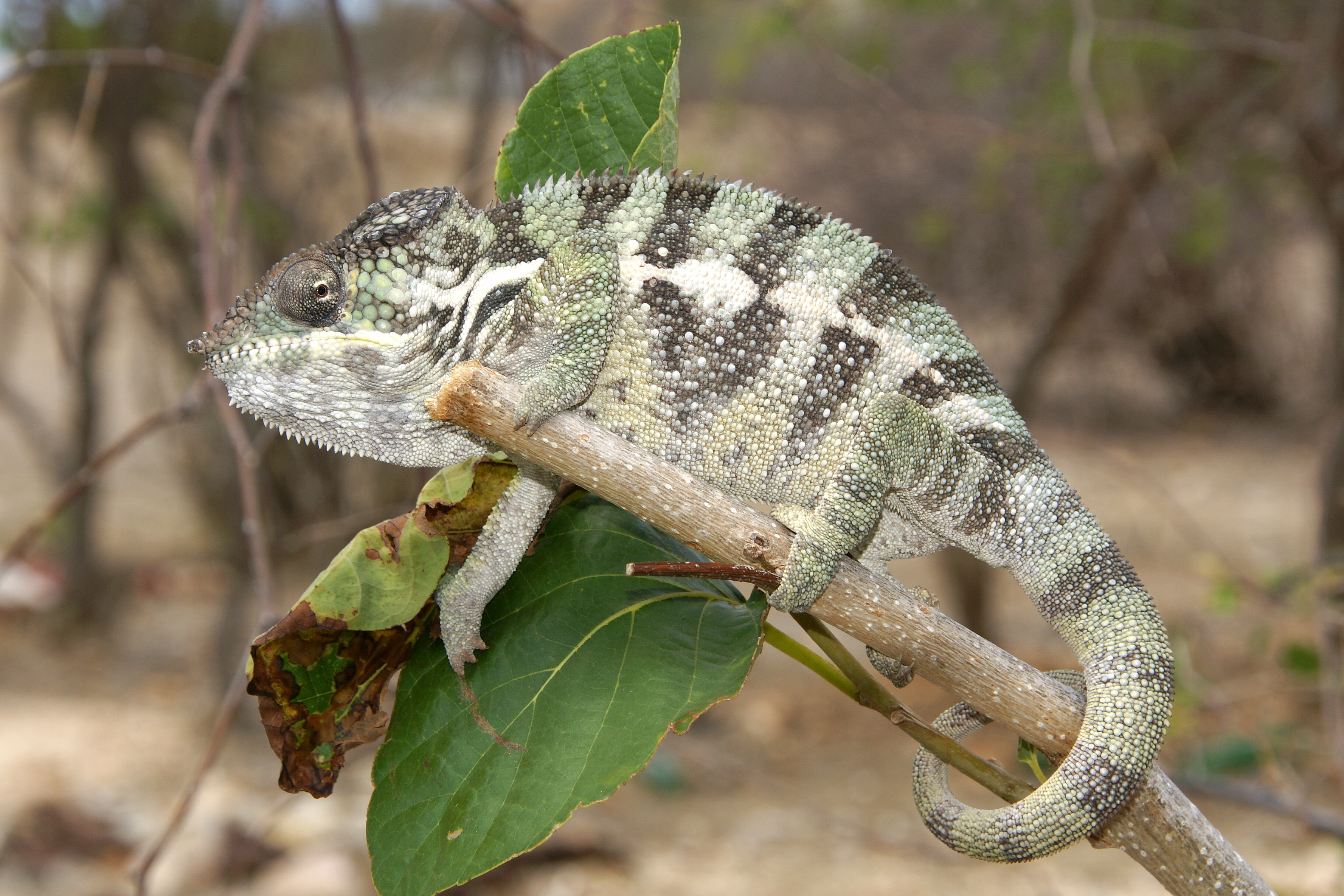

Terrarium
Panther Chameleons thrive best in vertically oriented, well-ventilated terrariums like the Exo Terra® Natural Terrariums and the Exo Terra® Screen Terrariums, as stagnant air and permanent high humidity are detrimental to the Panther Chameleon's health.
Exo Terra® Natural Terrariums, designed by European herpetologists, are the ideal arboreal enclosures for Panther Chameleons. These glass terrariums feature front opening doors, allowing easy access for maintenance and feeding and a unique double ventilation system with full screen stainless steel top. The full screen stainless steel top allows ultraviolet rays from UVB lights to penetrate deep inside the enclosure. The dual ventilation system allows sufficient airflow during the day, while it facilitates to keep the relative humidity at an optimal level during the night. In the back of the screen cover are 5 closable wire or tube inlets on both sides to facilitate the installation of powered accessories like waterfall pumps, filters, the Exo Terra's Monsoon, etc.
The Exo Terra® Screen Terrarium is a perfect habitat for arboreal reptiles that are sensitive to stagnant air. The non-restricted airflow provides optimal ventilation while minimizing odors and fungus growth in your reptile’s habitat. The screen design provides a broader temperature gradient, which helps your Panther Chameleons to regulate their body temperature more effectively and prevents overheating. The aluminum screen mesh allows ultraviolet rays from UVB lights or the sun to penetrate deep inside the enclosure. The substrate tray allows you to place a small layer of substrate to absorb spray water and increase humidity levels. The substrate tray can easily be removed from the enclosure through the swiveling bottom door. The sturdy latches add stability to the enclosure and keep your Panther Chameleons safe & secure.
The set-up can be a simple “sterile-type set-up" with an Exo Terra® Moss Mat, a Dripper Plant with a Water Dish, a potted live plant in combination with some Exo Terra® hanging plants, and some branches and Exo Terra® Vines as climbing space. Or you can offer your Panther Chameleon a more natural, “bio-active type set-up” by replacing the Exo Terra® Moss Mat with a Tropical Forest floor created by a bottom layer of Sub Stratum, a middle layer of Plantation Soil, topped with Ardisia leaves (Equatorial Forest Floor).
Never house 2 male Panther Chameleons together in one terrarium as they tend to be very territorial.
DISCLAIMER In regards to the pet species and number of specimens to be kept in a terrarium, always comply with the species specific Rules and Regulations in your Country of residence.
DISCLAIMER The terrarium should be placed in a room receiving only indirect light from windows. Do not place the Terrarium near a window where it can receive direct sunlight, as this could cause the terrarium to overheat and stress or kill your Panther Chameleon.
Lighting
Panther Chameleons are diurnal, meaning they’re active during daylight. Since Panther Chameleon are heliophilic, meaning they are attracted to sunlight, we have to provide them with a combination of sufficient visual light, UVA, UVB and Heat rays during daytime.
A 12-hour day/night cycle is an adequate photoperiod for the healthy all-year-round keeping of your Panther Chameleons. The more natural approach, and to induce breeding, is to provide 13 hours of daylight and 11 hours of nighttime during most of the year, and reduce the daylight cycle to 11 hours daylight and 13 hours nighttime during the months of May through mid-August.
The lighting for Panther Chameleons consists of 2 parts. A very important role for the illumination of heliophilic Chameleons is reserved for the visible light in combination with UV radiation. The other part of the "lighting" is actually a combination of "light & heat" in the form of incandescent bulbs. Chameleons do not recognise non-visible heat sources like ceramic heat emitters, heat cables, heat mats, etc.
Proper UVB Lighting is VITAL for your Panther Chameleons! It is very important that the upper ⅓ of the terrarium is reserved for proper basking spaces at different levels, so the Chameleon can actively thermoregulate and UV-regulate by targeted basking. The correct UVB wavelength assures that provitamin D3 (7-Dehydrocholesterol) can be converted into pre-Vitamin D3. Once this is formed, the heat rays will then provide the correct temperature for the thermal isomerisation into actual Vitamin D3. Without the combination of light, heat and UVB, your Panther Chameleon cannot produce the necessary Vitamin D3 to absorb calcium from their food. A major dietary problem in captive reptiles is the low assimilation of calcium from their daily food. Calcium is vital for bone growth and maintenance, muscle function, and many of the body’s most important metabolic functions.
There are various solutions to offer your Panther Chameleons quality lighting. You can either go for all-in-one bulbs like the Exo Terra® Solar Glo or Solar Ray, which provide optimal levels of UVA, UVB, visual light and heat all in one bulb! These bulbs deliver a consistent spectrum, which closely approximates that of natural sunlight, contributing to the animal’s overall wellbeing. The combination of the correct UVB wavelength and heat enables the animal to produce its own vitamin D3 for proper calcium absorption and prevents metabolic diseases (e.g. MBD). The powerful light output and balanced UV rays stimulate appetite and breeding behavior, while improving the physiological health of reptiles.
Or you can choose to combine fluorescent UVB lighting (like the Reptile UVB150/200 linear or Reptile UVB150/200 compact) with an incandescent heat bulb (like the Exo Terra® Intense Basking Spot or Halogen Basking Spot).
In order to increase the overall visible light, the Exo Terra® TerraSky Planted Terrarium Light is the ideal LED lighting solution for planted setups and bioactive terrariums. The high intensity and enhanced penetration ensure that the light reaches all layers of the terrarium, resulting in sustained lush plant growth. Orchids, Bromeliads, Tillandsias (air plants), carnivorous plants, mosses and lichen all thrive under the TerraSky Planted Terrarium Light’s strong Photosynthetic Active Radiation (PAR). The 120-degree light dispersion provides a nice even illumination and covers the complete area to avoid dark spots.
Heating
Monitoring
Panther Chameleons require a specific temperature range both during nighttime and daytime to thrive (see “Heating”). They also do best at a moderate relative humidity of around 70% during daytime and about 90% at night.
Use the Exo Terra® Digital or Analog Thermometers and Hygrometers to help you monitor the terrarium conditions and adjust the temperature and relative humidity to meet the needs of the animals. It is best to always use 2 Thermometers, one placed at the coolest end of the terrarium and the other one placed at the warmer end.
For more security and peace of mind, the Exo Terra® Thermostats or Thermostat & Hygrostat will help to prevent overheating and undercooling during hot summer days or cold winter nights. Apart from the temperature, the Exo Terra® Thermostat & Hygrostat will also help keep the humidity at the desired level. With the Exo Terra® Thermostats or Thermostat & Hygrostat you can create a well-controlled heating/humidifying system that allows you to maintain the required temperature and/or humidity conditions similar to those found in your animal's environment.
Substrates
Chameleons are primarily arboreal and don't bother too much about the kind of substrate used in their housing, except when females need to lay their eggs or when temperature and humidity conditions become unbearable.
The set-up can be a simple “sterile-type set-up" with an Exo Terra® Moss Mat, a Dripper Plant with a Water Dish, a potted live plant in combination with some Exo Terra® hanging plants, and some branches and Exo Terra® Vines as climbing space. Or you can offer your Panther Chameleon a more natural, “bio-active type set-up” by replacing the Exo Terra® Moss Mat with a Tropical Forest floor created by a bottom layer of Sub Stratum, a middle layer of Plantation Soil, topped with Ardisia leaves (Equatorial Forest Floor).
1. “sterile-type set-up” The Exo Terra® Moss Mat is a convenient substrate choice especially for hatchling and young but also for adult Panther Chameleons. The Exo Terra Moss Mat is an extremely natural-looking terrarium substrate. Soft, hygienic and absorbent the Exo Terra Moss Mat is easy to use and can be cut to fit any terrarium size. It allows you to perfectly spot-clean the bottom part of the Chameleon's terrarium for maximum hygiene. Simply rinse clean when soiled or replace as necessary.
2. “bio-active type set-up”
a. The substrate layer can consist of a single layer of Exo Terra® Sub Stratum, Exo Terra® Plantation Soil or a mixture of both, which will provide the benefits of both substrates.
The live bacteria in the Exo Terra® Sub Stratum will activate when the substrate comes in contact with water or waste. The organic matter such as left-over food and animal waste will decompose over time. The absorbing properties of volcanic ash will eliminate odours by trapping the decomposed materials. By mixing the Exo Terra® Plantation Soil with Exo Terra® Sub Stratum, you enrich the substrate with the required minerals like calcium, nitrogen, potassium and phosphorus. It also aids in the water retention capacity and provide adequate air supply to the roots.
b. For advanced drainage and aeration, you can use the multi-layered Bio Drain System. In the Bio Drain System, you use an inorganic bottom drainage layer, like Exo Terra® Bio Drain Substrate or Exo Terra® Sub Stratum, which you cover completely with the non-decomposable Bio Drain Mesh. This will allow proper water drainage and aeration of the substrate layers you will built up on top. The actual substrate layer that will be used for planting can consist of mixture of Exo Terra® Sub Stratum with Exo Terra® Plantation Soil. The multi-layered Bio Drain System with the Sub Stratum and Plantation Soil mix will allow proper drainage and aeration, preventing foul smells often associated with damp soils.
The Exo Terra® Sub Stratum is a natural volcanic soil with live beneficial bacteria. The porous surface and low-density structure allow for excellent drainage and aeration, but it also promotes a flourishing population of beneficial, nitrifying bacteria, creating a self-sustaining, living terrarium ecosystem. The active beneficial bacteria of the soil will decompose biological waste, keeping the terrarium clean and healthy.
The Exo Terra® Plantation Soil is a 100% natural, biodegradable terrarium substrate made from sustainable, ground coconut husk fiber grown on plantations in tropical Asia. The unique hygroscopic properties of this ecological substrate regulate the terrarium’s humidity in a natural way. The unique coir pith used for the Exo Terra® Plantation Soil consists of a mixture of short fibers and coco-peat grain sizes ranging from coarse granules to fine clumps resulting in improved soil drainage and aeration. The improved aeration of the substrate promotes the cultivation of healthy waste-reducing organisms keeping your terrarium fresh and clean.
The substrate should be kept slightly moist, but definitely not soaking wet, at all times. Make sure to offer different gradients of moisture inside the terrarium. Some parts can be kept rather moist while other parts should be kept somewhat drier. Also, try to vary the moisture depending on the season, spray more frequently during the warmer parts of the year. Preferably spray before the lights are switched on, and after they have been turned off.
The Exo Terra® substrates will help maintain the substrate moisture at an optimal level. Providing a top layer of Exo Terra® Leaf Litter or Forest Moss will also facilitate the substrate's moisture retention and prevent it from drying out. The Leaf Litter or Forest Moss will facilitate the natural ecosystem where beneficial organisms will break-down waste products and thus reduce odors.
The secret to growing healthy plants begins with the soil. Naturally, healthy soil contains living microorganisms — from bacteria to fungi, protozoa and arthropods. Together they form a choreographed exchange from the recycling of nutrients to the decomposition of organic materials.
Plants
Living an arboreal life in the warm and humid lowland coastal forests in Madagascar, Panther Chameleons spend all of their day, and even the nights, on branches and between the foliage of bushes and plants. This means plants in the terrarium, are not only important for decorative purposes, but they also allow you to recreate the micro habitat your Panther Chameleons live in.
For Panther Chameleons, plants have various purposes. The branches of the plants are used for climbing, while the dense foliage is used as a visual barrier, for thermoregulation, and the top leaves are used to drink dew droplets from in the morning.
The Panther Chameleon's zygodactylous feet are perfectly adapted to their all-day lifestyle of drinking, sunbathing, walking, eating, hiding, mating, sleeping, all while never leaving the branches of the shrubs they live in. In the terrarium, the branches of sturdy plants represent the natural environment for your Chameleons. Next to the plant's branches, the terrarium should be decorated with additional branches that reach out above the dense foliage to serve as basking area's (see Decoration).
Chameleons are generally shy animals, which perform their complex social behavior over distance and don't like to be seen, unless they choose to. For this, it is very important that the middle part of the Terrarium consists of dense foliage, as this will provide a visual barrier in which the Chameleon can retreat whenever it feels like. This is a very important factor, as it provides the Chameleon with a feeling of security and thus reduces stress. Once the Chameleon feels secure, it will show itself a lot more, knowing that it can retreat rapidly whenever it feels at risk.
This dense foliage will also provide a perfect microclimate within the Terrarium. The temperature will be lower than in the basking area above, while the humidity will be somewhat higher. This microclimate allows the Chameleon to thermoregulate its body temperature and regulate its exposure to UV by withdrawing itself from the basking area. While hiding from the heat and UV rays, the Chameleon can also replenish some moisture through their nostrils and respiratory tract.
Chameleons, and many other arboreal reptiles, generally do not recognise motionless bodies of water as a drinking source. In nature, they hydrate mainly through the exposure to fog at night and drink dew droplets that formed on the leaves in the morning, or rain drops that remained on the leaves after a short rain. These water drops are recognised by the Chameleons as a drinking source. Spraying or misting the terrarium plants in the morning and evening will provide water droplets for your Chameleon to drink. Exo Terra® designed a plant for this specific drinking behaviour, the Exo Terra® Dripper Plant (see Watering).
Adding a mix of decorative live and Exo Terra® artificial plants to your terrarium will provide more space for spraying droplets, provide extra cover, and increase the aesthetics of the terrarium interior design.
Many hobbyists choose to introduce live plants in pots that are buried in the substrate and concealed with decor items, like cork bark or rocks. Using live plants, such as Pothos, Hibiscus, Ficus or Schefflera, provides hiding spots and contributes to the bioactive process in the terrarium. The Exo Terra® Snake Bowl is ideal for use as a decorative planting pot. Its extra deep design makes it suitable for small to medium live terrarium plants.
DISCLAIMER Make sure the plants have no pests before introduction and rinse leaves thoroughly to remove any pesticide residues.
Exo Terra® offers a wide range of artificial plant with the same advantages as live plants; they're decorative, they provide shade, and they create hiding spots and visual barriers to let your reptiles and amphibians experience an increased feeling of safety and reduced stress. Exo Terra's artificial plants are exact copies of their natural counterparts to blend in well with live plants but are much easier to maintain. A combination of live plants and Exo Terra's artificial plants allows you to fully plant a terrarium, even in the hottest or driest parts. Exo Terra®'s Hanging Plants hold spray water longer and are easy to clean & maintain.
Hide Outs
Plants are the #1 visual barrier in a Chameleon Terrarium. An abundance of live plants in combination with Exo Terra® Hanging Plants will provide your Chameleon with sufficient hiding space.
Decor
Landscaping a terrarium will encourage activity and exploratory behaviours.
A combination of live and artificial plants with Exo Terra® Forest Branches and Exo Terra® Vines should be used to maximize 3-dimensional climbing space. The combination of Forest Branches and Vines allows you to create diagonally as well as horizontally oriented climbing space and basking areas. The upper ⅓ of the terrarium should consist of basking areas at various levels, that are free from foliage. This will help your Panther Chameleon to move between the basking area and the hiding space between the foliage to thermoregulate and regulate UV exposure.
The Exo Terra® Forest Branches resemble aged hardwood branches as seen in tropical forests.
The Exo Terra® Jungle Vines & Moss Vines can be used for decorative purposes as well as for enlargement of the dwelling area. These water-proof vines are bendable, twistable life-like vines with a natural feel and look and can be twisted together with vines of different sizes to create a 3-D habitat. The Exo Terra® Jungle Vines and Moss Vines can be combined to enhance the natural Rainforest-look of your Terrarium.
The Exo Terra® Dripper Plant should be part of the decoration as well, as this realistic plant was designed to meet the watering needs of tree dwelling reptiles and amphibians like e.g., Chameleons (see Watering).
Nutrition
Panther Chameleons are insectivorous and should be fed with a variety of live, canned or vacuum-packed insects of appropriate size. As a general rule the maximum size of the insects should be the width of the Chameleon’s head. Offer as much variety of insects in your Panther Chameleon's diet as possible, to make sure that your Chameleon receives all essential nutrients. All live insects should be gut-loaded with nutritious foods, like apple slices, sweet potato, oranges, cereals, bee pollen, etc. 24-48 hours prior to being fed to your Chameleon.
Because commercially raised insects tend to be deficient in calcium and several vitamins, they must be supplemented by coating with a reptile vitamin and mineral supplement such as Exo Terra® Multi Vitamin blended with an equal part Calcium. Always dust your feeder insects with a 1:1 mix of Exo Terra® Multi Vitamin and Calcium + D3 powder supplement using the “shake & bake” method of coating insects.
Hatchling and very young Panther Chameleons will need to be fed with live insects, but as they grow older, it is rather easy to train them to accept Canned or Vacuum-Packed Insects offered with a tweezer. Offering Canned or Vacuum-Packed Insects as an addition to the live insects, allows you to widen the dietary variety of food items tremendously.
Exo Terra® Canned or Vacuum-Packed insects can be fed right out of the can/pouch as these insects are well fed and vitamin-calcium coated.
Exo Terra® offers 11 varieties of Canned and Vacuum-Packed Foods which allow you to bring more variety in your Panther Chameleon's diet. Panther Chameleons will readily accept canned or vacuum-packed foods if you use tweezers to make the insects appear to be alive. Just hold the insect in front of the Chameleon and slowly wiggle it so it appears to be moving. Loosen the tweezers as soon as the Chameleon grabs the insect. The Exo Terra® Canned and Vacuum-Packed Specialty Reptile Foods are a convenient way to feed insect-eating reptiles, turtles, amphibians, fish and birds. These insects (and snails) have been cooked in the can to maintain nutritional value, flavor and aroma. The retorting process also softens the exoskeleton of the insects for easier digestion and breaks the bonds between the collagen protein to make it absorbable by reptiles. Collagen is an important fiber that aids in building bone, cartilage, skin and claw structures. Canned and Vacuum-Packed insects have the same nutritional value as live insects but are easier to digest. Visit our Canned and Vacuum-Packed Foods webpage for more information.
Feed juveniles daily and adults every other day.
Water
Chameleons, and many other arboreal reptiles, generally do not recognise motionless bodies of water as a drinking source. Occasionally some individuals drink from a Water Dish with standing water, but this is a water source you cannot rely on. In nature, they hydrate mainly through inhaling fog at night and additionally drinking dew droplets that formed on the leaves in the morning, or rain drops that remained on the leaves after a short rain. These water drops are recognised by the Chameleons as a drinking source. Especially if the drops roll over the leaf, or shimmer in the light of the terrarium.
Spraying or misting the terrarium plants manually in the morning (before the lights are switched on) and in the evening (after the lights have been switched off) will provide water droplets for your Chameleon to drink (Exo Terra® Mister or Mini Mister).
To simplify this task, and to ensure that spraying is always performed on time, Exo Terra® has designed the Monsoon, a programmable misting system that can be set to generate a fine mist at dedicated intervals during a 24-hour cycle. For Panther Chameleons, the best setting is to spray twice a day, once early in the morning, before the lights are switched on, and once in the evening, approximately 1 hour after the lights have been switched off.
In addition, to the regular spraying, a dripping system should be provided, so the Chameleon can drink sufficiently to stay hydrated. Exo Terra® designed a Smart Plant for this specific drinking behaviour, the Exo Terra® Dripper Plant. The Dripper Plant in combination with an Exo Terra® Water Dish assures your Chameleon to always have water droplets available.
Chameleons are very susceptible to dehydration and next to providing droplets by spraying and water dripping, we should keep a keen eye on the relative humidity in the Terrarium.
During daytime, the humidity should be kept at around 70%, while in the dense foliage in the middle of the terrarium, the humidity will probably be slightly higher. During nighttime, we have to increase the humidity much as it does in nature. With the Exo Terra® Humidifier or Fogger, you can increase the humidity to reach between 80-100% at night. This increased humidity will prevent moisture loss from the Chameleon's body and will even allow the Chameleon to replenish some of the moisture lost during daytime through their nostrils and respiratory tract.
The Exo Terra® Humidifier can help maintain the correct relative humidity in the terrarium, especially if used in combination with the Exo Terra® Thermostat & Hygrostat. The Thermostat & Hygrostat will help to prevent overheating and undercooling during hot summer days or cold winter nights, but will also keep the humidity at the desired level, if used in combination with an Exo Terra® Humidifier or Fogger. With the Exo Terra® Thermostat & Hygrostat you can create a well-controlled heating/humidifying system that allows you to maintain the required temperature and/or humidity conditions similar to those found in your animal's environment.
Make sure the Terrarium is well ventilated and the humidity is not kept permanently over 70% as Panther Chameleons are prone to infections if kept in permanent humid conditions.
Because Chameleons only drink water droplets formed by dew or rainwater, we recommend using purified water (reverse osmosis or distilled) or debris-free, clean rainwater for spraying/misting. The use of purified water (reverse osmosis or distilled) will also prolong the life of your watering devices and prevent mineral stains on the glass.
Maintenance
Panther Chameleons require a bit more attention than most reptiles, but still relatively less maintenance compared to most pets. It will only take a minimum of time every day to check the terrarium temperatures and humidity, spot-clean the terrarium as well as clean and refill their water supply devices.
Daily routine:
1. Check the overall well-being of your animals, are they agile, did they lose weight, etc.
2. Check the terrarium temperatures & humidity
3. Check if the Humidifier increased the humidity sufficiently at night, and if necessary, refill the reservoir
4. Spray the Terrarium plants to create water droplets on the leaves of the plants twice a day
5. If spraying is automated with a Monsoon, check if there's still sufficient water in the reservoir
6. Clean the Water Dish with Dripper Plant thoroughly and provide clean fresh water
7. Spot-clean the terrarium; remove feces and soiled substrate, dead insects and uneaten food to prevent harmful bacteria to build up
8. Feed canned, vacuum packed or live vitamin/mineral dusted insects daily or every other day depending on the age of your Panther Chameleon
Weekly routine:
1. Remove and clean hard surfaces if soiled
2. If a Moss Mat is used as substrate, remove and clean the Moss Mat thoroughly
3. If live plants are used in the terrarium, water these once a week
4. Clean the inside glass and decoration with plain water to remove any waste matter. The outside (NEVER the inside) glass can be cleaned with a paper towel and window cleaner
Breeding
In nature, mating takes place during the rainy season, and after a gestation period of about 5-6 weeks, the female deposits her 20-30 eggs. In captivity, however, the Panther Chameleons will adapt their mating behavior to the environmental conditions offered to them in the terrarium. And even Panther Chameleons kept at constant warm humid temperatures, without annual day-length fluctuations, are known to proceed with mating.
Before breeding your Panther Chameleons, make sure that the female is well-fed and healthy, so she has sufficient strength to produce and lay eggs.
It is in the reptile hobbyist's eye to recognise whenever a female becomes receptive. A receptive female shows softened pastel-colored tones, ranging from a light beige to a pinkish-orange. To induce breeding, place the female in the male's terrarium and carefully observe the coloration of the female once the male starts making his moves. As soon as the male notices the female, he will flatten his body towards the female and show his brightest colors to impress her. He will then approach the female with the typical wobbly Chameleon motion while bobbing his head. If the coloration darkens to almost black with bright orange spots, it means she is not receptive and needs to be returned to her own terrarium right-away. If, however, the coloration of the female remains passive, more or less the same as it was in her own cage, and she slowly walks away from the male, she is most likely receptive. The male will soon catch up with the female after which they proceed with the mating process. Leave the female in the male's terrarium for up to 4 days, or until she shows the warning coloration, dark brown to black with orange spots. Return the female to her own Terrarium and observe if, after a few days, she shows a somewhat fainter version of the warning coloration, you can assume she is pregnant.
Female Panther Chameleons have a unique mode of delayed fertilization or "Amphigonia retardata", meaning, they can store sperm from a single mating and fertilise future eggs without any further copulation, for at least up to 4 clutches.
After a gestation period of about 5-6 weeks, the female will be ready to deposit the clutch of up to 35 eggs. During this gestation timeframe you have to assure that the female has various suitable oviposition sites. When you notice the female becoming restless and performing random excavations, it will only take a couple of days before she deposits the eggs. The female prefers a 10-12" or 25-30cm deep, moist warm substrate layer which can consist of a mixture of Exo Terra® Plantation Soil with some Exo Terra® Desert Sand or Stone Desert clay sand. This mixture will assure that the female can dig a tunnel for egg laying without the tunnel collapsing. After the oviposition, the female will carefully close the tunnel again to make sure no predators will recognise the egg-laying site. Once the female has finalised laying and covering the eggs, provide drinking water as soon as possible, so she can regain some strength.
Carefully remove the eggs from the egg-laying site and place the eggs in an Exo Terra® Incubation Box (Suspended Incubation Method) or in a plastic container (when using the conventional substrate method). The eggs are about 0.31"x 0.55" or 8x14mm in dimension and weight about 0,7g. Both the conventional system using vermiculite, as well as the suspended incubation method, are described in the Exo Terra® Incubator PRO manual. Place the incubation containers in the Precision Incubator PRO and set the temperature between 75-79°F or 24-26°C with or without a slight 5-7°F or 3-4°C nighttime drop depending on your preference. Always have the Incubator operating for at least 24 hours to monitor temperatures before placing the eggs inside the Incubator. Regular temperature checks are required. The Exo Terra® Incubation Box comes with an integrated thermometer that allows you to check the actual temperature inside the egg incubation box rather than relying on the overall temperature measurement in the Incubator.
The incubation period takes about 180-340 days depending on the incubation temperature and fluctuations. Throughout the incubation time, the eggs will slowly increase in size, but shortly before the eggs hatch, they slightly shrink while small water droplets appear on the egg's surface. This sweating is the actual start for the hatching process, soon the baby chameleons will slit the egg membrane with their egg tooth and hatch.
The newly hatched Chameleons measure 65-75mm and can be kept in small groups for the first 2-3 months. Keep a keen eye on individuals that are growing faster than the other group members and separate them from the group, as they might suppress the smaller and weaker group members.
Handling
Panther Chameleons are animals that are best observed, but many owners choose to handle their Chameleons, just so they become used to being picked up and occasionally held. Panther Chameleons get used to their caretakers easily and tolerate moderate handling rather very well.
Refrain from handling hatchling Panther Chameleons until they have doubled in size (about 15 cm / 6"), as they feel uncomfortable being picked up.
Do not approach your Chameleon from above, as this may be misinterpreted as a predatory attack and result in a panic reaction. Make sure to use slow and gentle movements. Do not lift your Chameleon by its tail or limbs. Place your hand on the branch in front of your Chameleon and let the Chameleon move freely onto your hand. In case the Chameleon does not move onto your hand voluntarily, you can gently scoop it up from under its body. Try to support the whole body if possible, including its tail and limbs, or let the Chameleon climb on stick which you hold in your hand.
DISCLAIMER Always make sure to thoroughly wash and rinse your hands with warm water before and after handling any reptile, amphibian or invertebrate.

Conclusion
Panther Chameleons are an ideal beginner’s Chameleon and rank among the best kept and bred Chameleons in the World. They make beautiful display animals, especially in well-planted, well illuminated terrariums, where they show off their beautifully changing colours and patterns.

Did You Know?
Panther Chameleons are very common in their native country, that is why they have the IUCN predicate conservation status: LC “Least Concern”. Panther Chameleons are also abundantly available as captive bred specimen.
Panther Chameleons can hold on to a branch with their tail while dangling with their full body weight, in order to reach the next branch on their path.
Panther Chameleons have chameleodactylous, or parrot style feet, meaning on the front feet they have 2 merged toes on the outside and 3 merged toes on the inside, while on their hind feet it is vice versa. This allows a firm grip onto the branches of the trees they live in, even when there's very heavy winds.
Panther Chameleons have almost a 360° view of their surroundings. They can switch between monocular and binocular viewing depending if they want to survey their surroundings, or focus on a feeder insect.
The Chameleon's tongue is about 1,5 times as long as its body length and travels at a race car's speed.
Female Panther Chameleons have a kind of built-in pregnancy test. The female will change her overall coloration once she becomes pregnant. This becomes clearly visible when a male approaches. The female’s overall coloration and vertical bands darken to almost black with bright orange spots.
Frequently Asked Questions
My Panther Chameleon is turning white! Is it sick?
No, like all reptiles, Panther Chameleons shed their skin regularly. When about to shed, they will turn to a whitish colour. Shedding will then generally occur within 24 to 48 hours.
Is a Panther Chameleon the right choice for me?
Panther Chameleons are an ideal beginner’s Chameleon and rank among the best kept and bred Chameleons in the World. They make beautiful display animals, especially in well-planted, well illuminated terrariums, where they show-off their beautifully changing colours and patterns. Unlike night active creatures, Panther Chameleons are awake and active during daytime hours which is of course a big advantage for viewing pleasure. If you are looking for a hardy, relatively “easy-to-care-for” Chameleon and you can refrain from excessively handling your animal, a Panther Chameleon is perfect for you.
Can I keep 2 Panther Chameleon males together?
Do not house 2 or more male Panther Chameleon in 1 terrarium, they are very territorial and will fight and injure or kill each other.
Can I feed my Panther Chameleon wild caught insects?
We do not recommend feeding wild caught insects as these can harbor harmful bacteria. They may also have come in contact with gardening chemicals, making them poisonous for your Chameleon.
Should I feed a variety of food items to my Panther Chameleon or can I stick to just 1 type feeder insect?
Bring as much variation as possible in your Panther Chameleon's diet to make sure that your Chameleon receives all possible essential nutrients. With Exo Terra's Canned or Vacuum-Packed insects it's easy to offer a wide variety to make sure that your Chameleons receive all the nutrients they need. The Canned and Vacuum-Packed insects have the same nutritional value as live insects but are easier to digest.
Is it really necessary to provide a UVB light for my Panther Chameleons?

Notes from the Field
Discovery of a new Gecko
Madagascar, the land of mystique and wonder, has always been revered for its unparalleled biodiversity. Every step on this island is a testament to nature's grandeur. And there, in the midst of the towering bamboo of Ampisindava, was our stage, where nature's drama would unfold.
Jewels of the bamboo forest I
The day's adventures guided us from Ankify to Ampopo, along the shores of the Ampasindava Peninsula. As we approached, dolphins frolicked near our boat, offering a spectacle of nature's dance. The evening saw us under the open skies of Ampopo's virgin beach, with a crackling campfire warding off nature's nocturnal visitors.
Jewels of the bamboo forest II
With camp set up, our scientific endeavors began with the creation of pitfall traps to capture ground-dwelling reptiles and amphibians. Though a single tiny frog was all that was caught, the surrounding bamboo forests held more surprises.
Jewels of the bamboo forest III
Once we reached the bamboo forests, we were again stunned by the density of day geckos. In the internal bamboo forests of the Ampasindava peninsular, Phelsuma vanheygeni is very common. It shares its habitat with Phelsuma klemmeri, Phelsuma seippi, Phelsuma laticauda and the bigger Phelsuma madagascariensis grandis. Phelsuma vanheygeni is one of the smaller day gecko species that is well adapted to living in bamboo.
Phelsuma vanheygeni
Achim Lerner's initial description of Phelsuma vanheygeni in the 'Phelsuma' journal, courtesy of the Nature Protection Trust of Seychelles.
The Ampasindava Peninsula
The Exo Terra expedition left Paris for one of the remotest and inhospitable parts of the ‘Red Island’: Madagascar. It took the expedition team four flights, a 10-hour ocean trip and several hours by pirogue through the natural canals of the dense mangrove forests to finally install the first campsite. Although it was supposed to be the dry season, it wasn’t. Tents had to be erected in the pouring rain, and the team’s equipment was drenched. With everything soaked, the inside-out tent’s only remaining purpose was protection against the millions of biting mosquitoes. Madagascar is one of the world’s high-risk areas for Malaria, a mosquito-transmitted and often fatal disease.
Other species
Dendrobates leucomelas
Yellow-banded poison dart frogs are endemic to the western Guiana region and the northeastern Amazon basin of South America: southeastern Venezuela and small, adjacent parts of Colombia, Guyana and northern Brazil. They are long-lived, intriguing and “easy-to-care-for”. Because of their typical color combination consisting of a yellow to orange base color with contrasting black splotches and bands, they are also sometimes referred to as "Bumblebee dart frogs".
Like other poison dart frogs, their bright colours are actually a warning sign (called aposematic coloration) to inform predators that they are poisonous and should not be eaten.
Yellow-banded poison dart frogs live a mainly terrestrial lifestyle: they are bottom dwellers that spend most of their time on and in between the leaf litter that covers the forest floor. They do, however, also frequently climb vines and trees.
Their amazing colours and the fact that they are easy to care for make them appealing display animals for both the beginning amphibian enthusiast as well as for the advanced hobbyist. Yellow-banded poison dart frogs are best kept as pairs or groups consisting of a majority of males: females might express dominant and aggressive behaviour towards other females when there is a conflict of interest in a specific male.
Phyllomedusa hypochondrialis (Pithecopus hypochondrialis)
Tiger-Legged Monkey Frogs are native to Colombia, Venezuela, Suriname, Guyana & French Guyana, Brazil, Bolivia and Paraguay. They prefer tropical & subtropical dry and moist forests but can also be found in seasonally flooded grasslands. The type locality of the Tiger-Legged Monkey Frog referenced in the original description is Suriname.
The Tiger-Legged Monkey Frog's common name refers directly to the striped tiger markings on the inside of the frog's thighs. These frogs really deserve their common name as being Monkey Tree Frogs. Rather than jumping like other frogs do, they prefer to use their long, skinny legs to slowly walk in the trees in a monkey-like fashion. They're also one of the only frogs with opposable thumbs, allowing them to use their monkey-like "hands" to get a firm grip on the thin branches, while walking through the vegetation that they live on.
Tiger-Legged Monkey Frogs are stunning, long-lived and “easy-to-care-for” amphibians. Their engaging personalities, their bright green dorsal color, their orange with black tiger striped inner thighs and partially orange with irregular black stripes and blotches on the flanks, make them one of the most stunning display animals for both the beginning reptile enthusiast as well as for the advanced hobbyist.
Tiger-Legged Monkey Frogs live an arboreal lifestyle, sleeping on the back of the leaves in the trees and shrubs that they live in.
Tiger-Legged Monkey Frogs are a fairly social species and are best enjoyed when kept in small groups of 4 to 8 animals. The interaction between the animals in these small groups increases the viewing pleasure but also stimulates their mating behavior.
Tiger-Legged Monkey Frogs have been captive bred in the USA and Europe for decades. The somewhat larger cousin of the Tiger-Legged Monkey Frog (Phyllomedusa hypochondrialis), the Super Tiger Leg Monkey Tree Frog (Phyllomedusa tomopterna) is also being captive bred, but to a much lesser extent.
Pandinus imperator
The Emperor Scorpion, scientifically known as Pandinus imperator, is one of the most recognizable arachnids in the world of terrarium invertebrates. Being one of the largest scorpion species, their impressive size and striking appearance have fascinated many arachnid enthusiasts.
Emperor Scorpions are indigenous to the tropical rainforests and savannas of West Africa. Their habitat includes countries such as Ghana, Togo, Benin, Nigeria, Cameroon, and the Ivory Coast. They are usually found in leaf litter and burrows, where they seek shelter from the bright sun and heat of the African day.
While Emperor Scorpions are typically solitary in the wild, some experienced keepers have managed to house them together. However, it's crucial to note that aggression and stress can arise in group settings, so it's recommended to keep them individually.
Ranoidea caerulea (Litoria caerulea)
White’s Tree Frogs are native to Australia, Indonesia and Papua New Guinea. There are also some introduced populations in New Zealand and South Florida, USA. They primarily prefer moist and semi-moist forest habitats but can also cope with drier environments.
They are sometimes referred to as Dumpy Tree Frogs as well because of their somewhat chubby, sleepy appearance.
White's Tree Frogs are hardy, long-lived, docile and “easy-to-care-for” amphibians. Their engaging personalities, bluish-green color and milky white bellies, adorable smile and big golden eyes make them appealing display animals for both the beginning reptile enthusiast as well as for the advanced hobbyist.
White’s Tree Frogs are very tranquil and get accustomed to handling by their caretaker fairly easily. Dumpy Tree Frogs can be kept individually or in small groups of 2 – 8 animals. The interaction between the animals in these small groups increases the viewing pleasure but also stimulates their mating behavior.
White’s Tree Frogs have been captive bred in the USA and Europe for more than 30 years. They are available in various color morphs, green, blue, Snowflake (covered in white spots).
Oophaga pumilio
Strawberry poison dart frogs are endemic to Caribbean rainforests in Central America; from eastern central Nicaragua through Costa Rica to northwestern Panama.
The species is known for its extensive colour and pattern polymorphism, both within and among populations. The frog's look varies from a simple plain colour to a base colour covered with different shapes of dots, splotches and/or stripes, all of this with an endless variety of shades, such as blue, green, red, orange, yellow, black, brown and even white. Like other poison dart frogs, their bright colours are actually a warning sign to inform predators that they are poisonous and should not be eaten (aposematic coloration). Due to their colourful appearance and charismatic nature, they are often the subject of ecotourism related activities.
Strawberry poison dart frogs live a mainly terrestrial lifestyle: they are bottom dwellers that spend most of their time on and in between the leaf litter that covers the forest floor. They do, however, also frequently climb vines and trees.
Their amazing colours, charismatic nature and interesting breeding behaviour makes them appealing display animals. Strawberry poison dart frogs are best kept as pairs: females might express dominant and aggressive behaviour towards other females when there is a conflict of interest in a specific male.
Trachycephalus resinifictrix
Amazon Milk Frogs are native to Colombia, Equador, Peru, Bolivia, Venezuela, Suriname, Guyana & French Guyana and Brazil. They prefer tropical primary rainforests up to an elevation of 450m above sea level. The type locality of the Amazon Milk Frog referenced in the original description is Maracanã River in Pará, Brazil.
The Amazon Milk Frog's common name refers to the milky white secretions that these frogs release when they feel threatened. This behavior, however, is rarely seen in captive Milk Frogs. Trachycephalus resinifictrix is also sometimes referred to as the Mission Golden-eyed Tree Frog because the pupil in their golden iris resembles a black Maltese cross.
Amazon Milk Frogs are adorable, long-lived and “easy-to-care-for” amphibians. Their engaging personalities, the bluish-green color with distinct brown to black pattern, their blueish lips and toe pads and big golden eyes make them appealing display animals for both the beginning reptile enthusiast as well as for the advanced hobbyist.
Amazon Milk Frogs live an arboreal lifestyle, sleeping on the branches or in bark crevices and hollow tree trunks, always in the vicinity of the water filled tree holes they use for their reproductive cycle.
Amazon Milk Frogs are a fairly social species and are best enjoyed when kept in small groups of 4 to 8 animals. The interaction between the animals in these small groups increases the viewing pleasure but also stimulates their mating behavior.
Amazon Milk Frogs have been captive bred in the USA and Europe for more than 20+ years, and captive bred youngsters are readily available in reptile stores as well as from breeders.
Stay up on all things exo terra.
"*" indicates required fields

